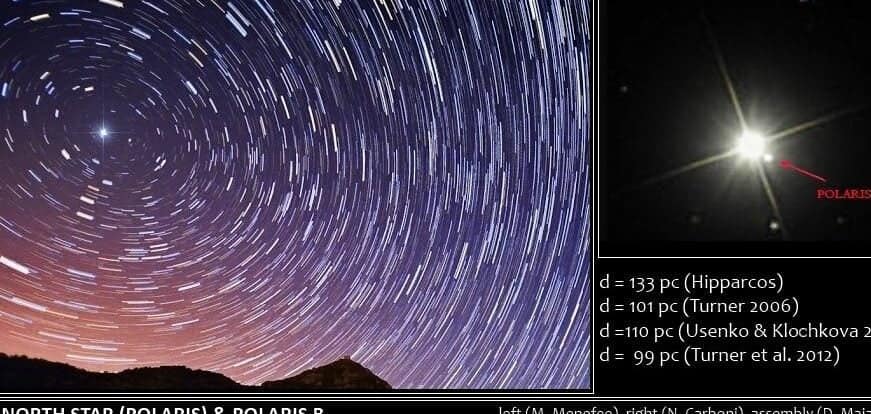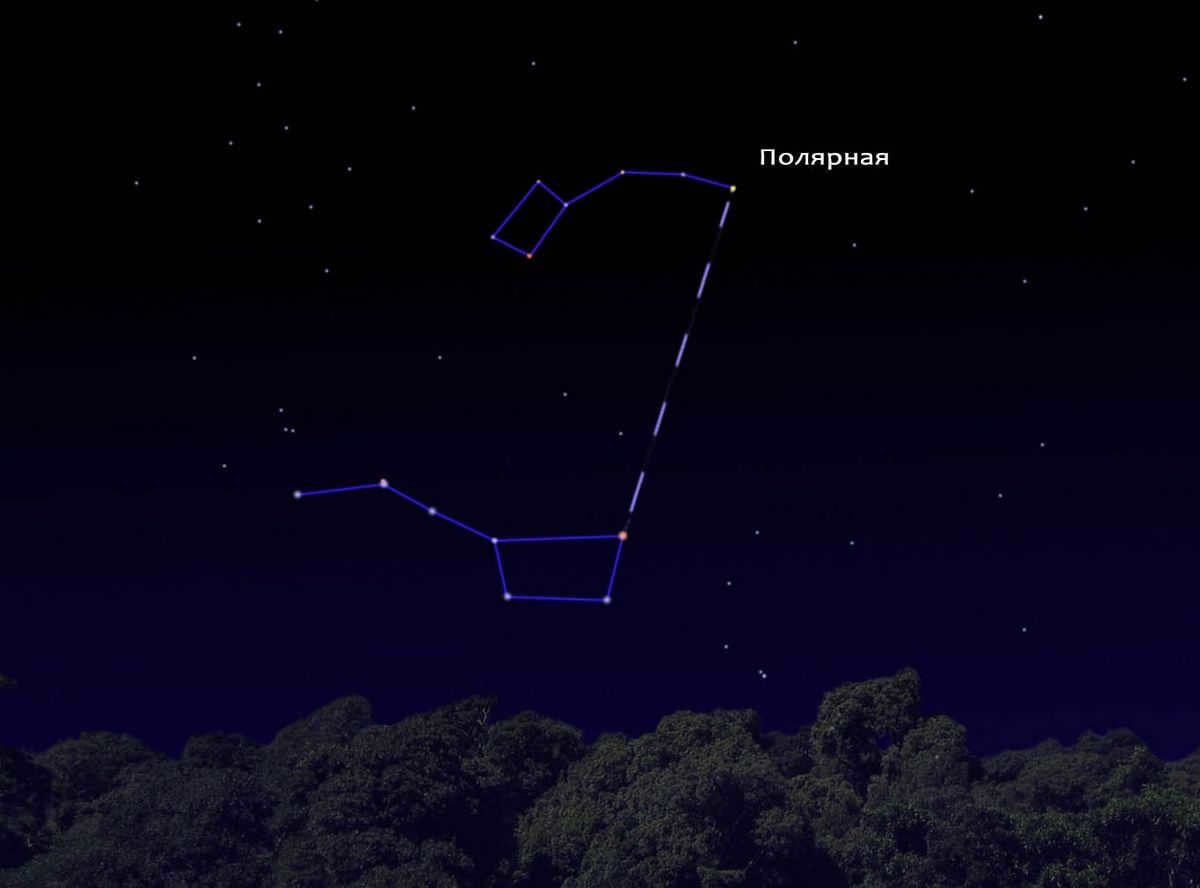
Residents of the Northern Hemisphere of the Earth are fortunate – they can determine the north even without a compass or landmarks by knowing how to locate Polaris. Polaris always remains in one part of the sky and points north more accurately than any other instrument, making it a valuable tool for astronomers to navigate accurately on the ground. Additionally, Polaris’s height above the horizon corresponds to the geographic latitude. But how can you locate this highly useful Polaris? Today, we will explore the fundamental techniques together.
Characteristics of Polaris and Common Misconceptions
Before embarking on a search for Polaris, it’s important to familiarize oneself with its key characteristics. This knowledge will not only facilitate a faster identification of Polaris in the vast expanse of the night sky, devoid of any signs labeling stars or outlining constellations, but also help avoid common errors. There are several prevalent misconceptions about Polaris, including:
- Which constellation does Polaris belong to? It belongs to the constellation Ursa Minor.
- In which part of the Big Dipper is Polaris located? It is located at the end of what is known as the handle of the Big Dipper.
- Where is Polaris not visible? It is not visible in the southern hemisphere, but at the equator’s latitude zero, it can be seen due to atmospheric diffraction (refraction of light).
- When searching for the Big Dipper in star clusters, it is necessary to locate the constellation known as the Dipper.
- Mentally connect the two farthest points of the Dipper with a straight line. The lower star is called Merak, while the upper star is called Dubhe.
- Increase the magnitude of the space between Merak and Dubhe by 5 times and extend it along the line connecting the upper point of the Dipper.
- The endpoint of this line reaches the edge of the handle of the Little Bear constellation.
- This endpoint is known as Polaris.
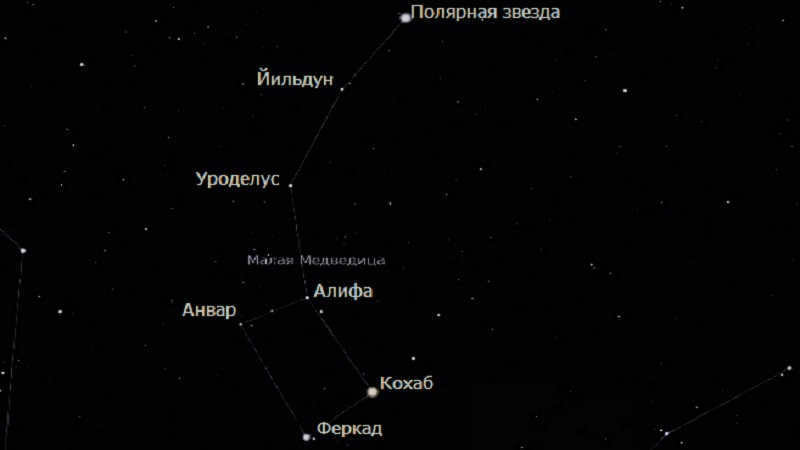
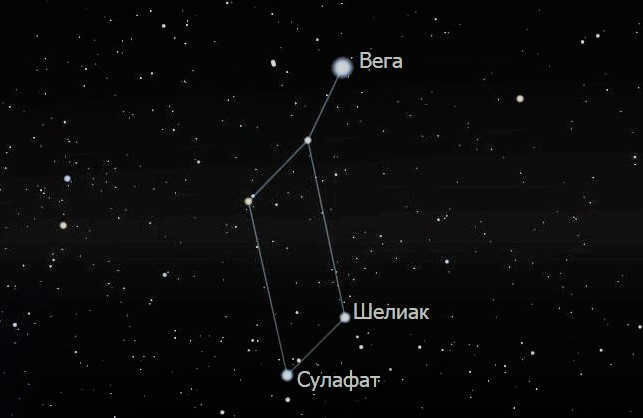
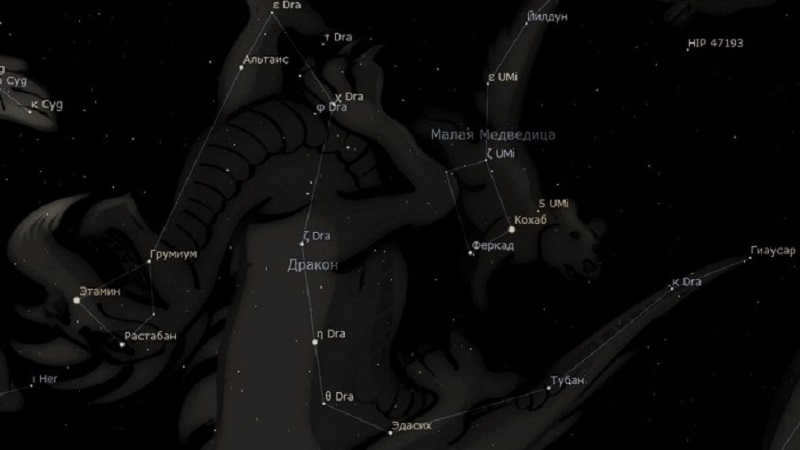
- Identify the two outermost stars in the Big Dipper formation, which form its outer “wall”.
- Mentally extend a straight line upwards from these two stars, approximately five times the distance between them.
- Imagine connecting with the handle end of the Little Bear’s dipper, and the tip of its handle represents Polaris, the North Star.
- Canis Major and Canis Minor (January)
- Leo (March)
- Capricornus (May)
- Taurus (November)
- Orion (December)
Polaris, also known as the “Pole Star,” is positioned directly above the North Pole of the Earth on the celestial sphere. However, it is not actually located at the zenith, or directly overhead. If it were, it would not be able to point to the north, as it would be positioned exactly in the center. In reality, Polaris can only be seen in the middle of the sky when observed from the North Pole. As one moves farther away from the pole, the star gradually descends lower towards the horizon until it is no longer visible at the equator. This is why Polaris cannot be used as a reference point in the southern hemisphere, where the direction is determined by the Southern Cross constellation.
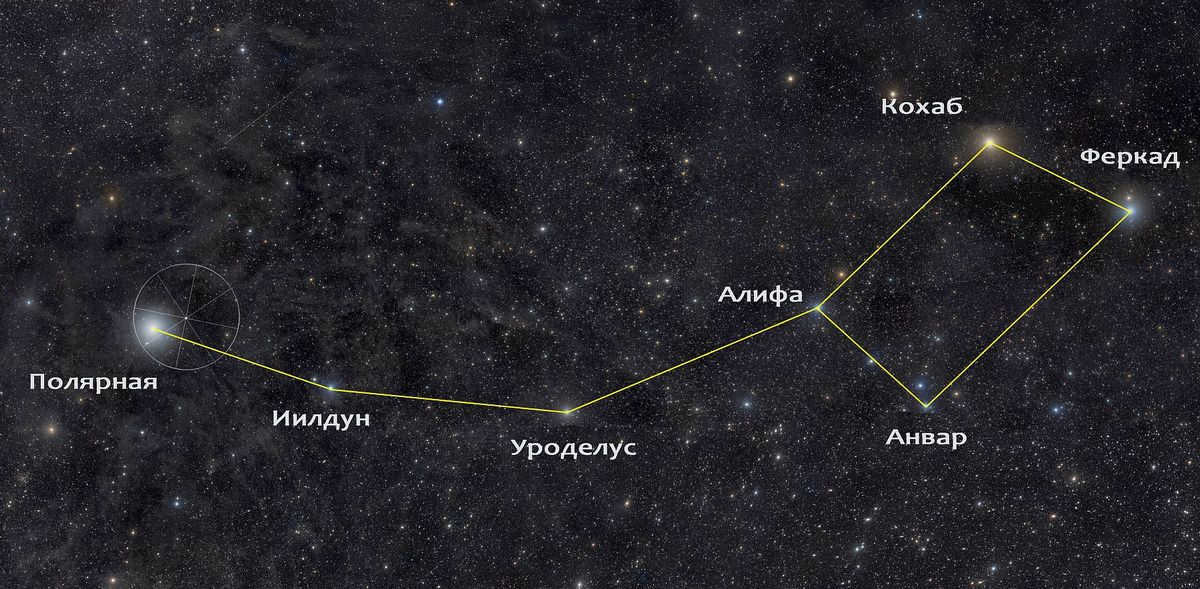
The Little Bear is home to Polaris, the star that is part of the constellation.
Where can you locate Polaris?
Now that we have an understanding of what Polaris is, it is time to begin the search. There are two primary methods we can use: searching based on constellations or utilizing technical tools.
Looking for Polaris through constellations
If the sky is not covered by clouds and your vision is capable of perceiving at least the most luminous stars, the most straightforward and quickest method to locate Polaris is by observing the constellations. This approach offers the benefit of precision, as the stars remain fixed relative to each other. Moreover, Polaris is also a part of the constellations – it can be found at the tip of the “tail” of the constellation Ursa Minor and serves as its most brilliant star.
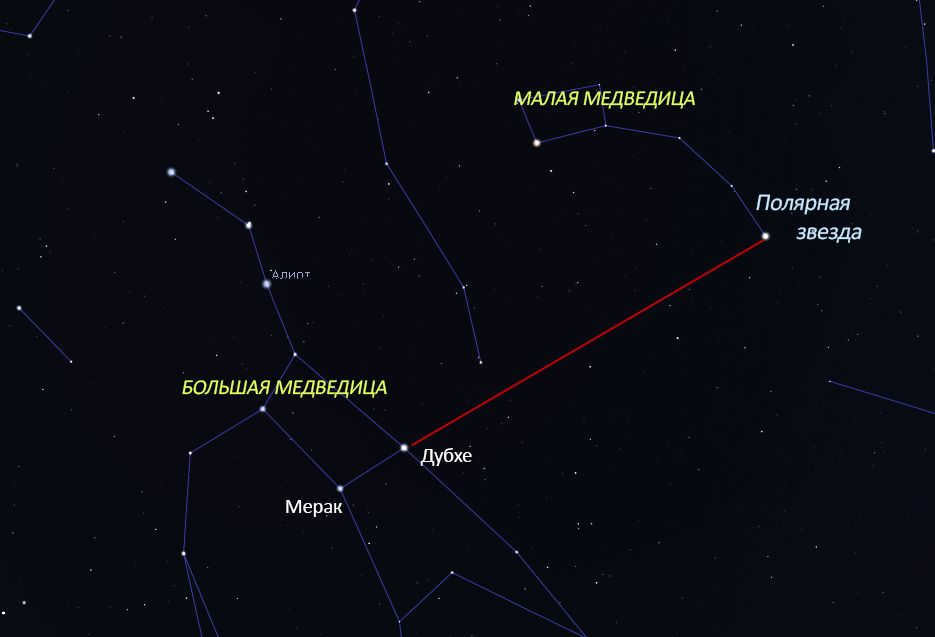
The Big Dipper, Little Dipper and Polaris
One way to easily locate Polaris is by finding the Big Dipper constellation in the sky. The main part of the Big Dipper, known as the Big Bucket, can be identified by its wide section at the “head” and the two stars that form it – Merak below and the brighter Dubhe above.
The Big Dipper revolves around Polaris in its rotation.
Let’s consider the scenario of the Great Bear and its Container. We will have the “tail” and the narrow side of the Container on the left, while the wide side will be on the right. On the broader section, locate two stars and sketch a direct line from the less luminous Merak to the brighter Dubhe. At a distance equivalent to 5 distances from Merak to Dubhe, you will come across the tip of the “tail” of the Ursa Minor and Polaris. Polaris is the most brilliant in that vicinity, making it difficult to make a mistake.
It is important to bear in mind that this technique primarily focuses on the individual constellations. The Great Bear and Ursa Minor, along with other constellations, are in constant motion across the sky – the Container can be both inverted and balanced “on the edge”. To facilitate drawing a straight line across the sky, you can utilize a ruler, a stick, or even your finger – this way, you won’t overlook Polaris.
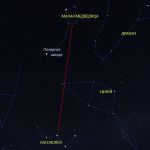
The constellation of the Little Dipper, Cepheus, and Cassiopeia
The Big Dipper is a relatively large star grouping, and thus may be partially or completely hidden by clouds or obstructions such as tall buildings and trees. As a result, the smaller yet equally notable constellation of Cassiopeia can also assist in locating Polaris. Depending on its orientation, it resembles either the letter “M” or “W”, albeit with slightly more elongated edges. Its central arrow always “points” towards the constellation of the Little Bear, where Polaris is situated. You can verify this by locating the nearby Big Dipper or Cepheus, a constellation positioned between the Little Dipper and Cassiopeia, resembling a house with a roof.
Let’s examine all of these approaches simultaneously. The preceding images depict the stars in the Moscow spring sky. The subsequent image displays the sky over Sochi on the same day, devoid of any labels or designations. Can you spot Polaris in it?
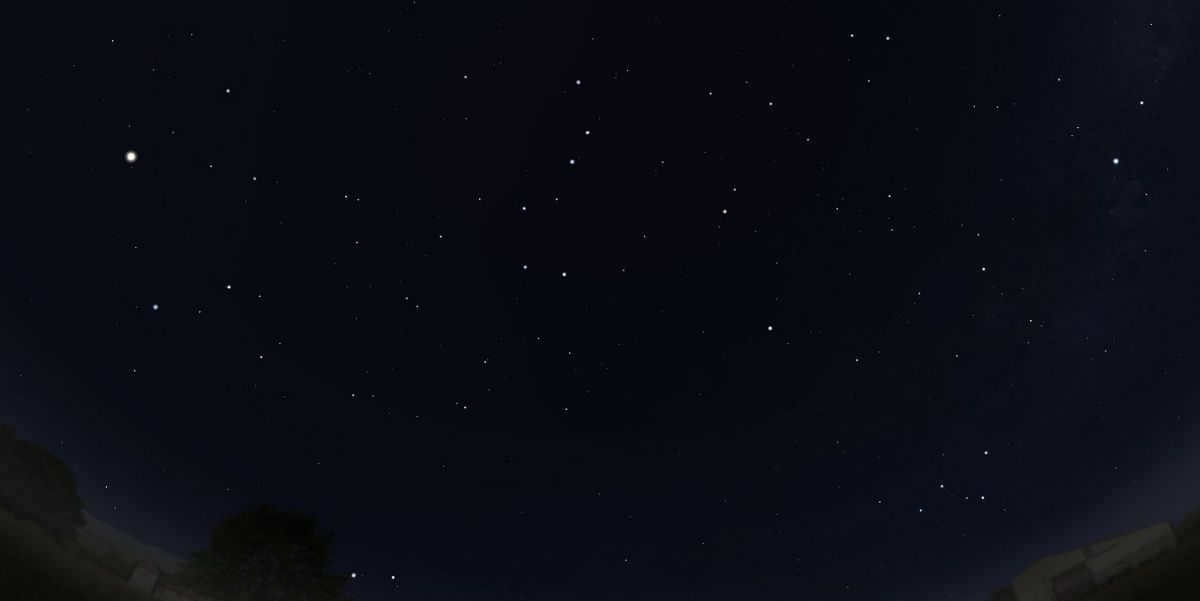
One of the stars that stands out among the rest is Polaris. Where can it be found? The answer is right here.
Utilizing technology
However, there are situations where it may not be feasible to locate constellations manually: obstructing trees block a portion of the sky, clouds are scattered unevenly across the celestial sphere, or the stars fail to form recognizable constellations due to lack of experience. In such cases, technological devices come to the aid in the quest for Polaris.
If you happen to have a camera on hand – preferably a popular “SLR” camera – then you have the opportunity to capture Polaris in your photographs. Many of you may have seen images of the night sky with long exposure times, where the moving stars create luminous trails across the sky. The length of these trails indicates the distance the stars have traveled. As Polaris is located at the axis of the celestial sphere and remains relatively stationary, the resulting image will showcase concentric circles of star trails, with the smallest and shortest one representing the track of Polaris.
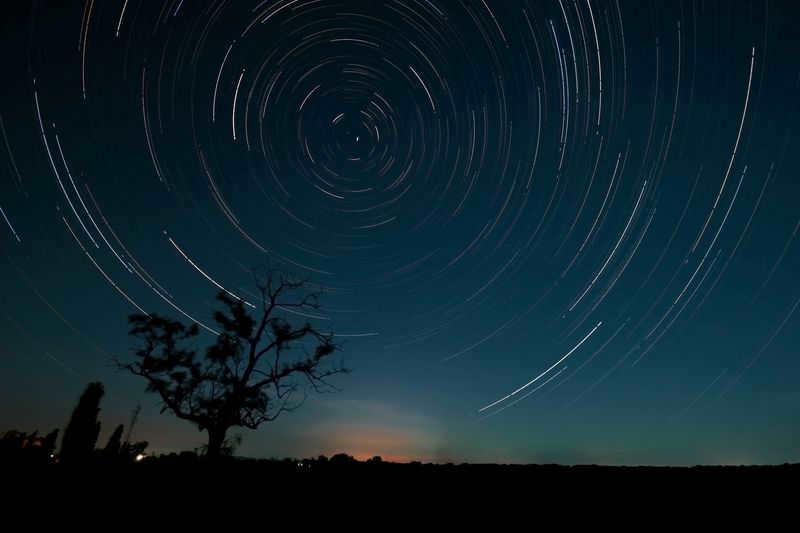
If you do not possess a suitable camera, you can utilize specialized mobile applications. For instance, there is an Android app called Stellarium and an iOS app called Sky Guide, along with various other alternatives. These apps can assist you in identifying constellations in the night sky by utilizing your smartphone’s camera or by calculating their position based on a specific location, season, and time of day. This functionality is particularly beneficial, as although these programs enhance the camera’s capabilities, it is often technically limited in capturing the stars.
Did you enjoy the video? Share it with your friends!
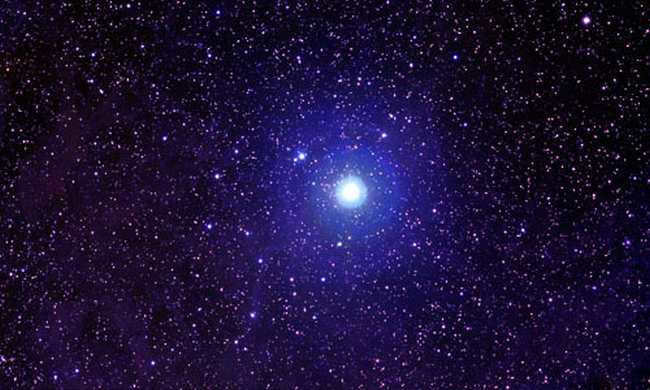
Polaris, also known as α UMI or α of the Little Bear, is the most luminous star in the Little Bear constellation. It is often referred to as the guiding star because it consistently indicates the northern direction. Situated in close proximity to the world’s northern celestial pole, it currently serves as the north Polaris.
Overall Description
Polaris is a star that is larger in size compared to the Sun. It consists of a main luminary, α Umi Aa, as well as two smaller companions named α Umi B and α Umi Ab. Additionally, there are two more distant components known as α Umi C and α Umi D. The discovery of the star α UMi B can be credited to astronomer William Herschel, who made the finding in 1780. Polaris is part of a constellation called the Little Dipper, which is highly favored by those interested in astronomy. This asterism is widely recognized and appreciated, along with other notable ones such as the Big Dipper, Orion’s belt, and Cassiopeia.

Stars of the Little Bear. The Little Bear constellation is beloved by children not only because it allows them to recognize the starry sky, but also because of the fascinating Greek mythology legends associated with it. So, almost all kids know that Polaris, the North Star, is located in the Little Bear constellation. It is also visible almost overhead for observers in the Northern hemisphere during winter, and at the North Pole, it can be seen at the zenith. Although Polaris does not exhibit the same beauty as other stars and lacks the presence of stunning nebulae and galaxies when observed through a telescope, it is always a reliable guide on the star map for navigation purposes.
One of the trending subjects is the determination of the distance to Polaris, as we are still uncertain about its exact proximity to Earth. Based on the most recent findings, Polaris is believed to be approximately 434 light years away or 133 parsecs. However, there are some experts who propose that it could be 30% nearer to our planet. Alpha Minor serves as the nearest variable cepheid to Earth, making its physical characteristics vital in the calculation of the astronomical distance scale.
The arrangement of the Polaris star system
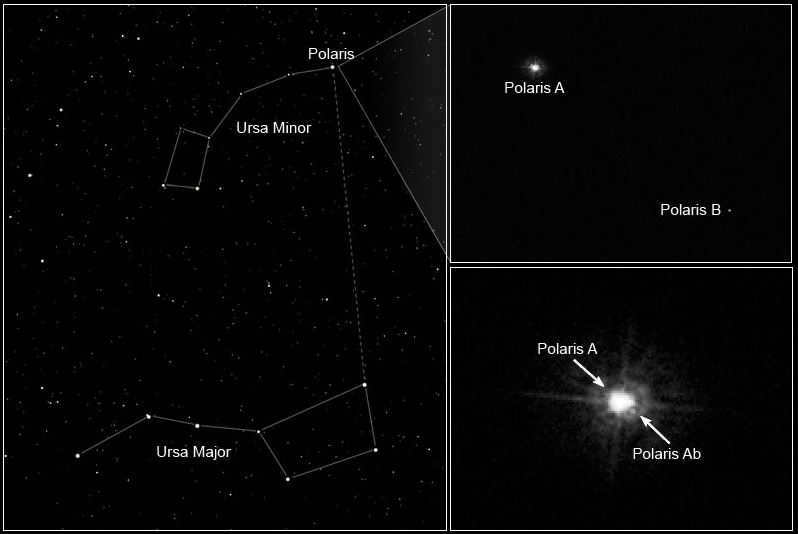
The Little Bear’s alpha alpha, as captured by the Hubble Telescope
α UMi Aa, also known as Polaris, is recognized for its mass, which is 4.5 times that of the Sun, and its spectral class of F7, which categorizes it as a supergiant (Ib). It is the first classical Cepheid to have its mass directly measured thanks to the presence of satellites.
The two smaller companions, α Umi B, with a weight of 1.39 solar masses and a spectral class of F3, are situated 2400 AU away. α Umi Ab, on the other hand, is a very close F6 main-sequence star with an orbital radius of 18.8 AU and a weight of 1.26 solar masses. There are also two distant components, α Umi C and α Umi D, but they are not physically associated with Polaris.
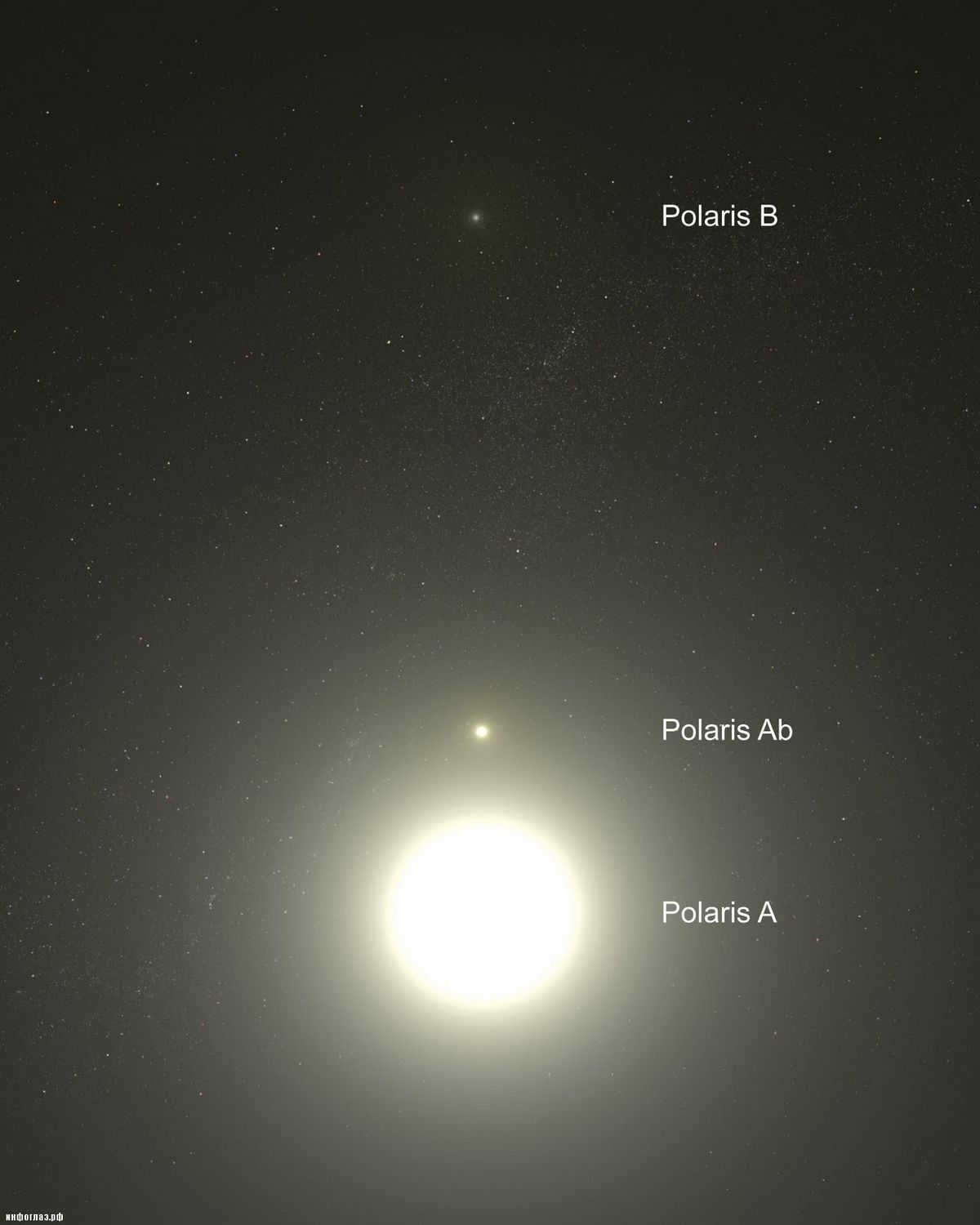
The Polaris star system is depicted in the image above.
Polaris B (α UMi B) can be observed using a simple telescope. It was first spotted by William Herschel in 1780 using his own reflector telescope, one of the most advanced telescopes of that time. In 1929, researchers discovered that Polaris A is actually a close binary system with a faint companion star (α Umi Ab) through spectral analysis. In January 2006, NASA released Hubble Telescope images that revealed all three members of the triple system. The closest star to Polaris is located 18.5 astronomical units (2.8 billion km) away, which explains why we only detected the light from the smaller satellite in 2006.
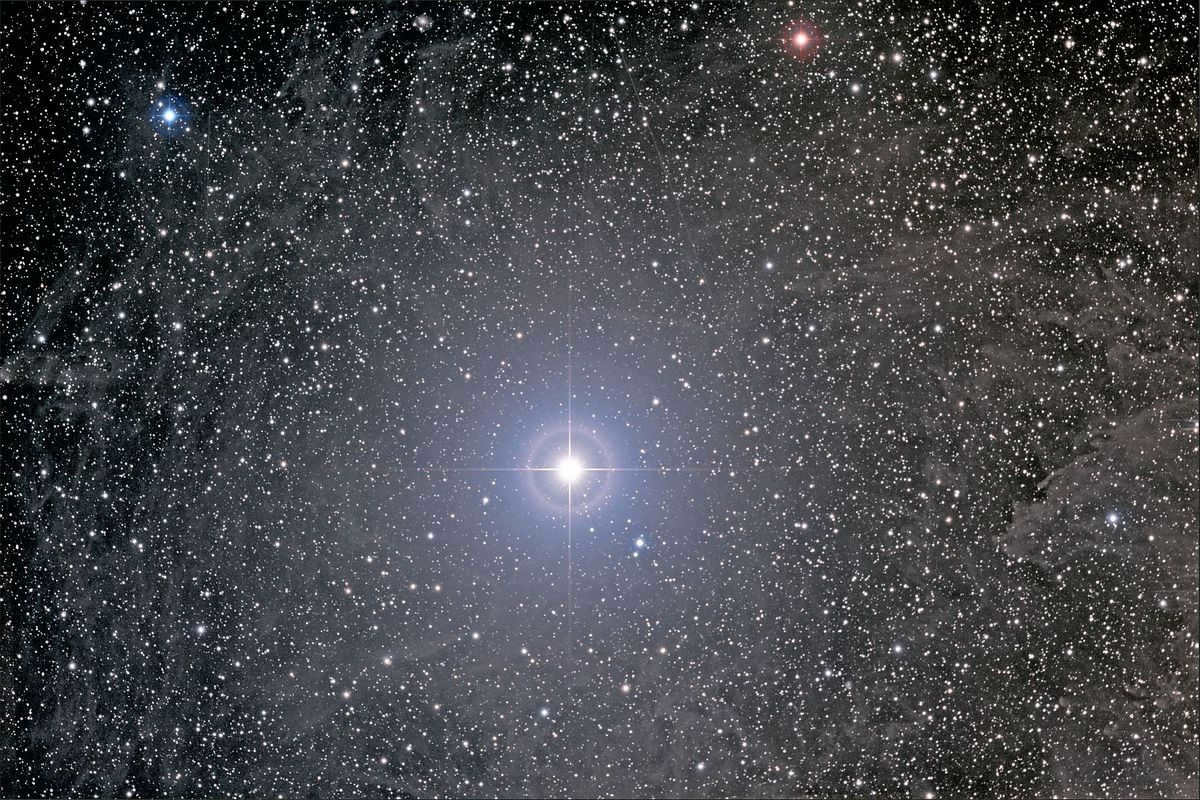
The photograph captures the nebula surrounding Polaris during a long exposure.
Polaris, a supergiant star, exhibits typical physical properties. When observed through a small telescope or binoculars, the star appears yellowish in color, which may come as a surprise since many people expect it to be white. In reality, Polaris is only slightly hotter than our Sun, with a surface temperature of approximately 6000 K. However, this is where the similarities end.
Similar to other visible stars in the sky, Polaris appears brighter than the Sun when observed from the same distance. Spectral analysis confirms that Polaris belongs to the supergiant category. It has a diameter 23 times larger than that of our Sun and a luminosity 2500 times greater! Even Sirius pales in comparison.
Topic-based materials
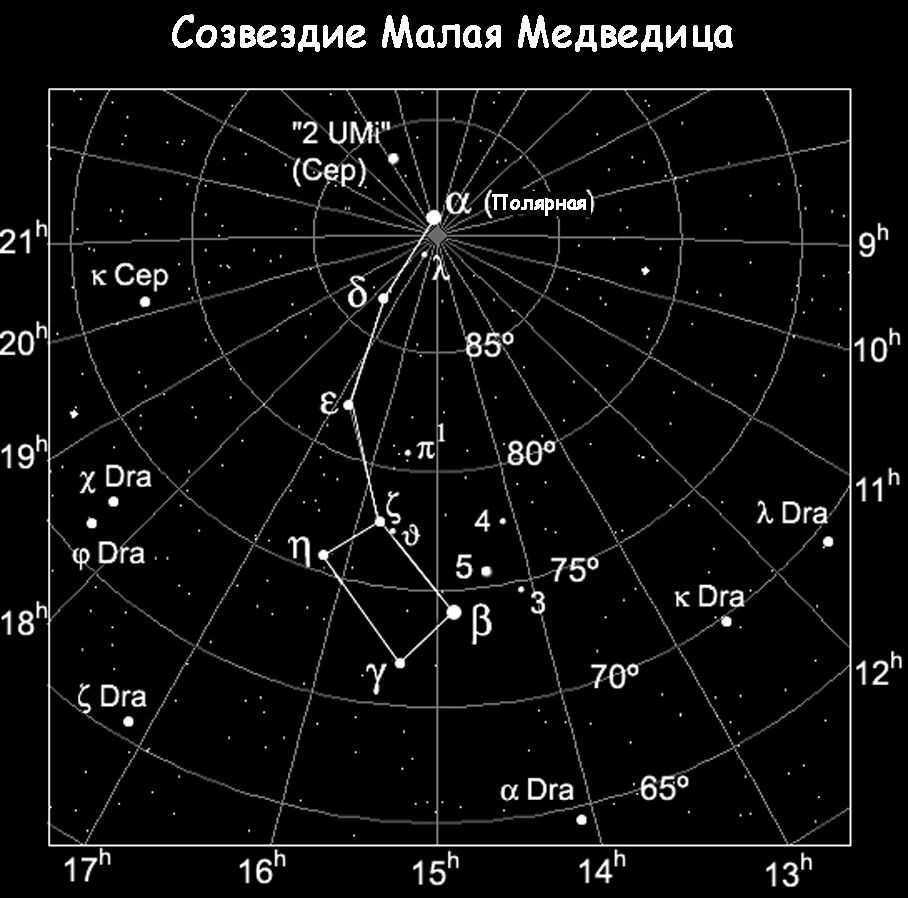
However, there is a caveat; estimating the distance to Alpha Minor of the Little Bear is a challenge for astronomers, which can cause variations in the calculations of brightness and temperature.
The existence of a supergiant
In comparison to the Sun, the life of a supergiant is relatively short and occurs after the depletion of hydrogen in its core. Supergiants are typically aged and highly evolved entities. This does not imply that they are old in terms of age, but rather indicates that their life cycle is already approaching its end, unlike the Sun.
It can be inferred that Polaris was once a relatively bright blue star in the Milky Way galaxy, belonging to the Β spectral class. Its mass was approximately 5 times that of the Sun, and its radius was 3.5 times larger. The surface temperature of Polaris was around 18,000 K, which is three times hotter than the Sun. However, these characteristics have changed over time, as indicated above.
Polaris is an enormous star, primarily consisting of the classical variable known as the Cepheid. As the closest Cepheid, the akmaf of the Little Bear has been extensively investigated and examined by numerous generations of astronomers, as Cepheids serve as a crucial benchmark for calculating distances. Its variability was initially suspected in 1852 and later verified by Einar Hertzsprung in 1911.
The luminosity and amplitude of the object have been measured
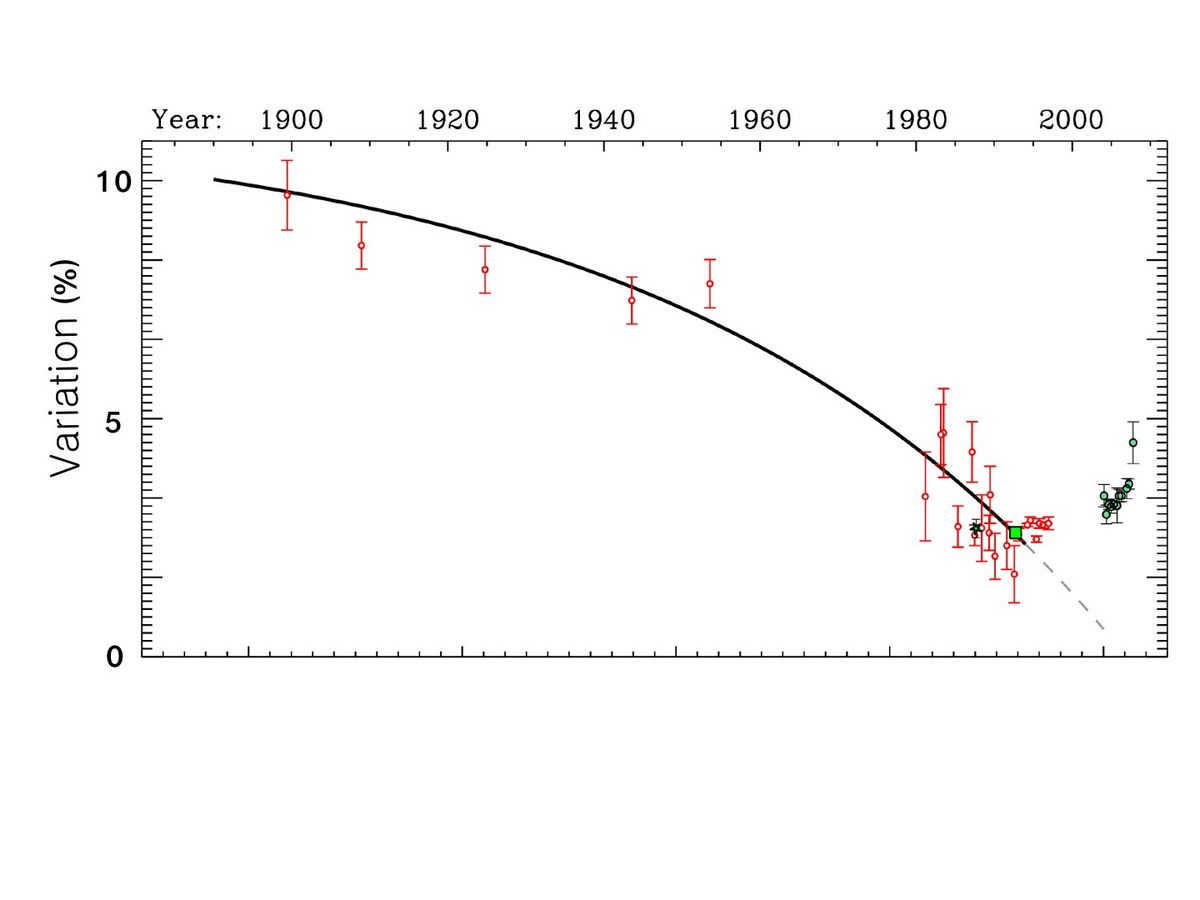
The amplitude of the 4-day luminosity has been decreasing over a span of more than 100 years.
Since its discovery, the amplitude and period of variation have been identifiable. Prior to 1963, the variation in light had an amplitude of more than 0.1 star magnitude, but gradually decreased. From 1966 onwards, the amplitude decreased rapidly, falling below 0.05 star magnitude, and has since been fluctuating erratically within this range. Based on measurements, the period of luminosity change is approximately 3.97 days, and it is currently on the rise. The period was steadily increasing at a rate of 4 seconds per year until 1963. It then remained constant for three years before resuming its upward trend in 1966. Present measurements indicate a consistent increase of 3.2 seconds per year.
Research indicates that Polaris is now 2.5 times more radiant in the sky compared to when it was observed by Ptolemy.
Cepheids
Cepheids are a type of variable star that have been crucial in measuring astronomical distances. These stars have a unique property where their brightness fluctuates over time. By studying the period of these brightness fluctuations, astronomers can determine the star’s intrinsic luminosity. This information, combined with the observed brightness, allows astronomers to calculate the distance to the star. Cepheids have played a significant role in determining the scale of the universe and have been used to measure distances to galaxies, nebulae, and other celestial objects. Their importance in astronomy cannot be overstated.
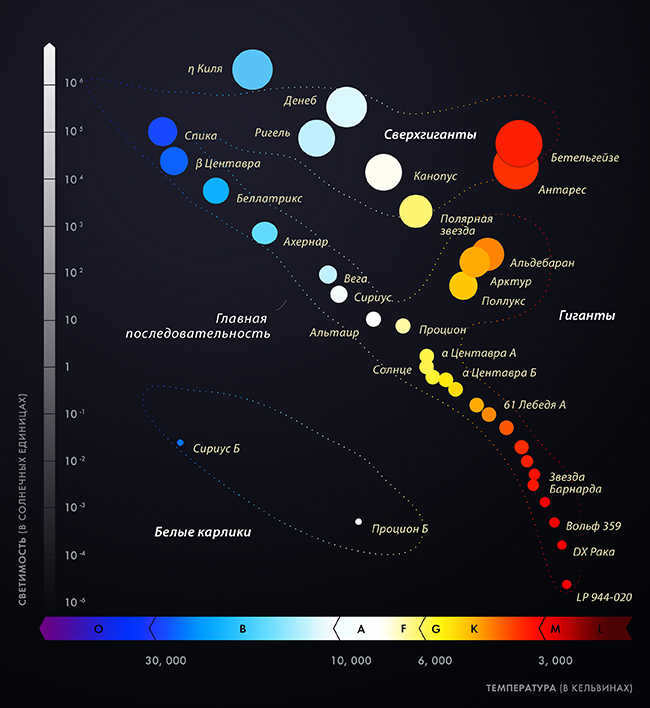

Placement on the Hertzsprung-Russell diagram
Astronomers are familiar with many stars similar to Polaris in terms of their physical characteristics, but they have identified a distinct group known as Cepheids (named after the star δ Cepheus). While Cepheids exhibit similar pulsations, they vary greatly in appearance, unlike neutron stars which appear almost identical. Cepheids differ in size, mass, temperature, as well as their pulsation periods and amplitudes. However, all Cepheids share an interesting correlation: their luminosity is directly related to their pulsation period, meaning that the longer the period, the greater the luminosity.
During its era, the relationship between brightness and pulsation periods played a significant role as it provided a reliable method for determining distances to Cepheids and other galaxies. In total, there are approximately 40 Cepheids that are considered classical and can be seen with the naked eye. You may be wondering what sets Polaris apart from the rest. Aside from serving as a guide to the north, it is also the closest and brightest cepheid to us. Given that these variable stars are utilized as a type of astronomical “rulers,” scientists are extremely meticulous and thorough in studying their variability.
Etymology of the title
What is the reason behind the name Polaris? Due to its significant role in astronavigation, being only 0.7 degrees away from the celestial pole, it has acquired several names. One of its historical aliases is Cynosura, derived from the Greek term for “tail of the dog”.
Function as Polaris
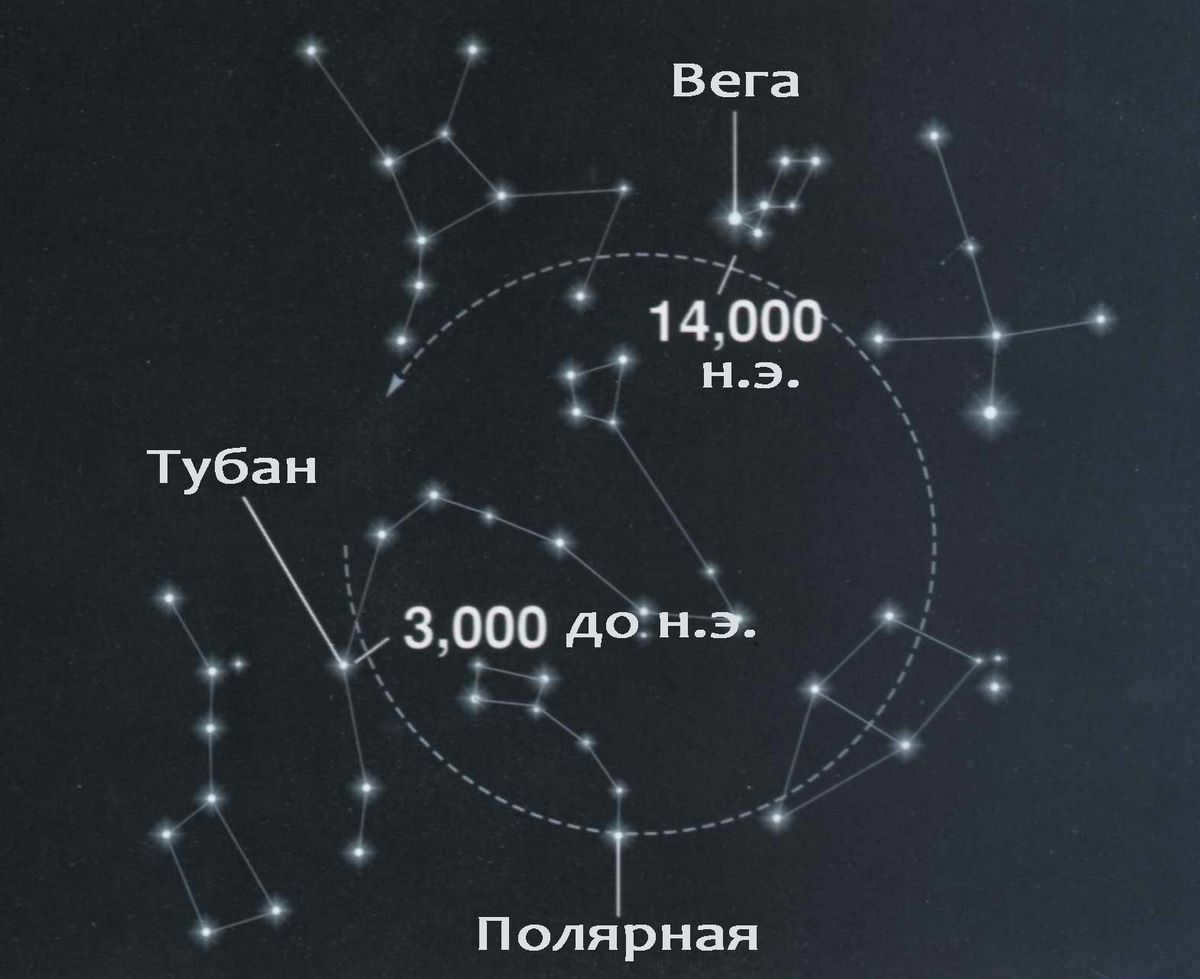
What is the direction that Polaris indicates? Due to its close alignment with the Earth’s axis of rotation, the star α Umi points directly to the North Pole. In the sky, α Umi remains nearly stationary, while all other stars in the Northern Hemisphere orbit around it. However, does its visual position change? Yes, but this occurs over an extremely long period of time, typically spanning hundreds of years. This alignment of the Earth’s axis and Polaris is crucial for navigation and astrometry purposes.
The way it travels through the heavens

One way to capture such an image is by gradually increasing the zoom of the camera lens over a period of several hours.
Now let’s examine how the position of the Alpha star in Ursa Minor changes over time. Its future movement is connected to the Earth’s axis precession. After the 21st century, the imaginary axis of the world’s pole will shift away from Alpha Ursa Minoris, and Gamma Cephei will become the next North Star around the 41st century. Around 2500 BC, the North Pole was near the star Thuban (Alpha Draconis), and during ancient times, it was close to Kochab (Beta Ursa Minoris). In approximately 320 BC, the Greek sailor Pytheas described the celestial pole as a place without any visible stars. However, Alpha Ursa Minoris has been recognized as one of the brightest stars near the North Pole since at least the Middle Ages.
At the moment, it is just 0.7 degrees away from the global pole (equivalent to a distance of 1.4 Lunar disks), causing it to orbit the pole within a small 1.5-degree circle.
Collection of star trails encircling the North Pole of the Earth
Click the button located at the upper right corner to switch to full screen mode.
Distance
There have been numerous studies conducted on calculating the distance, and they indicate that the alpha of the Little Bear is situated approximately 434 light-years (133 parsecs) away. These findings align with the parallax measurements obtained from the Hipparchos astrometric satellite (Hipparcos). Previous estimations of the distance were slightly lower, but recent investigations utilizing high-precision spectral analysis propose that it is actually 100 light-years closer to our location than previously believed. Polaris serves as the nearest variable, a Cepheid, and its physical characteristics play a vital role in the overall astronomical distance scale. It is worth noting that Polaris is the sole Cepheid whose mass can be accurately determined due to its companion stars.
Hipparchus’s Measurements
Hipparchus’s spacecraft, which utilized the technique of determining stellar parallax (the yearly angular shift of an object), conducted measurements on millions of stars between 1989 and 1993. These measurements were conducted with a precision of 0.97 angular milliseconds (equivalent to 970 microseconds), enabling the acquisition of precise data regarding the distances to numerous stars as well as the directions of their movements.
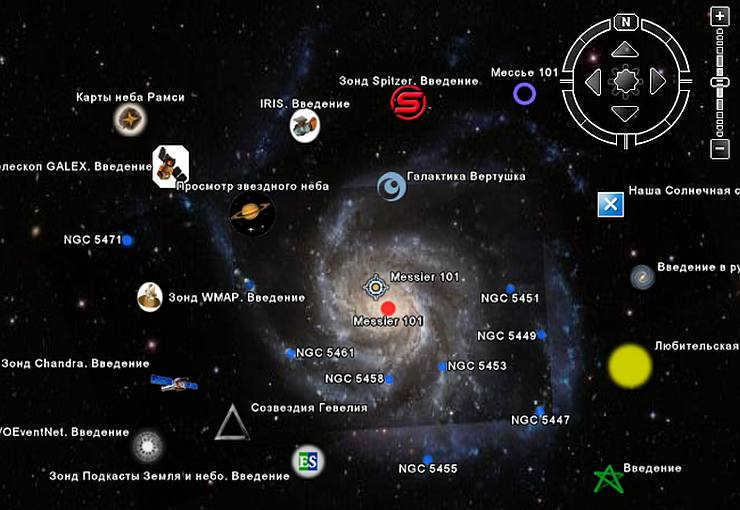
While Hipparchus’s astrometry has its advantages, there were already concerns about the accuracy of the data, and some studies have raised doubts about the validity of Hipparchus’s measurements.
The next significant development in precise parallax measurement is the Gaia spacecraft, which was launched in 2013 and is expected to collect data that can measure stellar distances with an error of 10% and within 20 microseconds of arc for 8,000 distant stars. Although Gaia cannot measure bright stars like Alpha Minor of the Little Bear, its research will contribute to refining the positions of other stars that serve as distance indicators. Radio telescopes have also played a role in obtaining accurate parallax measurements over long distances, although they require a rare combination of a compact radio source in close proximity to the star.
Table of distances to Alpha of Ursa Minor
Polar on other planets
How can you determine if Alpha of Ursa Minor will serve as a reference point on Mars or not? The criteria for identifying Polaris on other planets are the same as on Earth: they must have a magnitude brighter than 6th, meaning they can be seen with the naked eye under optimal conditions. Additionally, their position must align almost perfectly with the projection of the planet’s rotational axis on the celestial sphere. Each planet has its own poles, as their rotational axes are oriented differently.
Alpha of the Painter serves as the south pole on Mercury, while Omicron of the Dragon serves as the north pole.
42 of the Dragon is the nearest point to the north pole of Venus, while Goldfish is the nearest point to the south pole.
Delta Goldfish is the name given to Polaris on the Moon, as it is located near the axis of rotation of our satellite’s south pole.
Cap of Sails is just a few degrees away from the south pole of Mars. Additionally, the two stars Sadr and Deneb from the asterism “Northern Cross” in the Swan constellation are also near the North Pole of Mars. Earthlings are certainly more fortunate in this regard.
Polaris at Saturn’s South Pole is known as Delta Octanthus.
The Serpentine constellation points to the North Pole of Uranus, while the constellation Orion’s 15th star points to the South Pole of Uranus.
Neptune’s north pole is located halfway between the stars gamma and delta Swan. Its south pole, on the other hand, is occupied by the star Gamma Sails.
South Polaris
Rewrite the text, making it unique, using the English language and preserving the HTML markup:
South Polaris
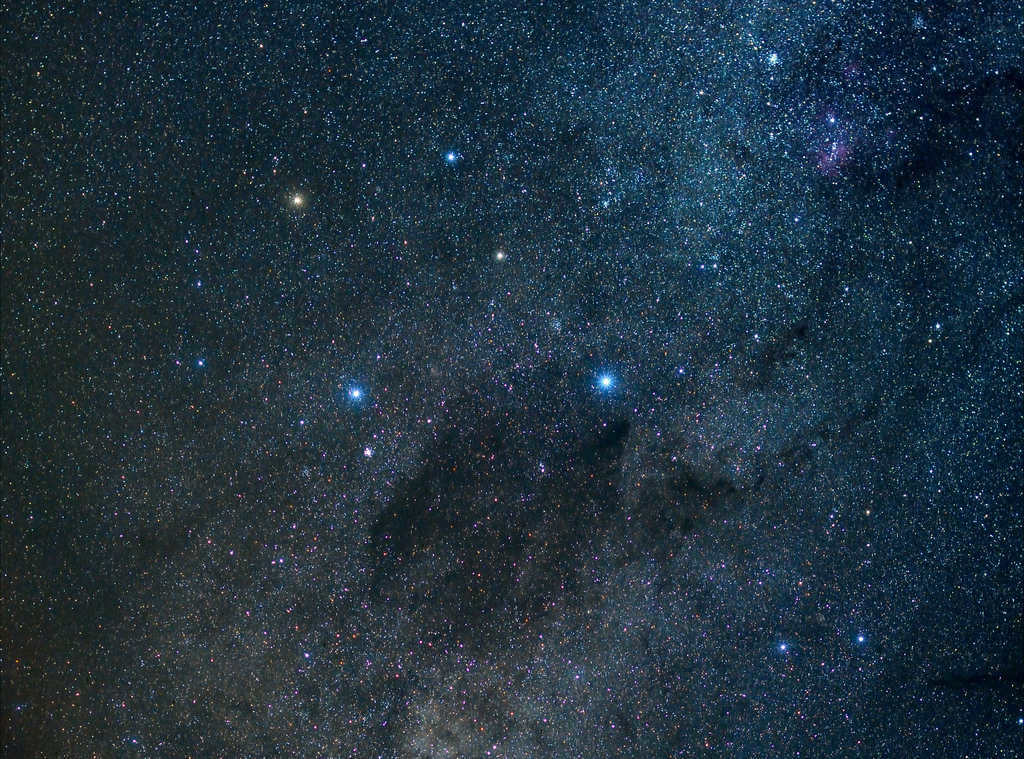
Influence of axial precession
The movement of the South Pole of the Earth is greatly impacted by axial precession. Currently, there is no prominent star located at the south pole of the celestial sphere. However, due to the gradual changes in the rotation axis, other celestial bodies will eventually take on the role of being the southern pole.
One notable change caused by axial precession is the movement of the celestial south pole towards the constellation of the Southern Cross. This constellation has been pointing towards the south pole for the past 2000 years. As a result, it is no longer visible from subtropical northern latitudes, unlike during the time of the ancient Greeks.
Throughout history, various stars have held the position of being the closest to the South Pole. Around 2000 B.C., Eta Hydra was the nearest bright star to the South Pole. In 2800 BC, Ahernar (Alpha Eridanus) was only 8 degrees away from the South Pole.
In the next 7500 years, the imaginary axis of the South Pole will approach the imaginary axis of the South Pole stars Gamma Chameleon (around 4200 AD), I Kiel, Omega Kiel (5800 AD), Epsilon Kiel, Iota Kiel (8100 AD), and Delta Sails (9200 AD). From A.D. 8000 to 9000, the South Pole will traverse the constellation of Sails. In 14000 AD, Capopus (Alpha Kiel) will be 8 degrees away from the South Pole.
Coordinates of the place

Currently, the brightness of Polaris, also known as Alpha of the Little Bear, is moderately high with an apparent stellar magnitude of 1.97 (which can vary). Its declination is +89°19’8″ (or +89°15’51.2″ during the J2000 epoch), which means it always points towards the north within approximately one degree. Interestingly, Polaris remains fixed in the sky, and it is not visible at the equator without considering atmospheric diffraction. However, it would not be accurate to consider this as a complete observation.
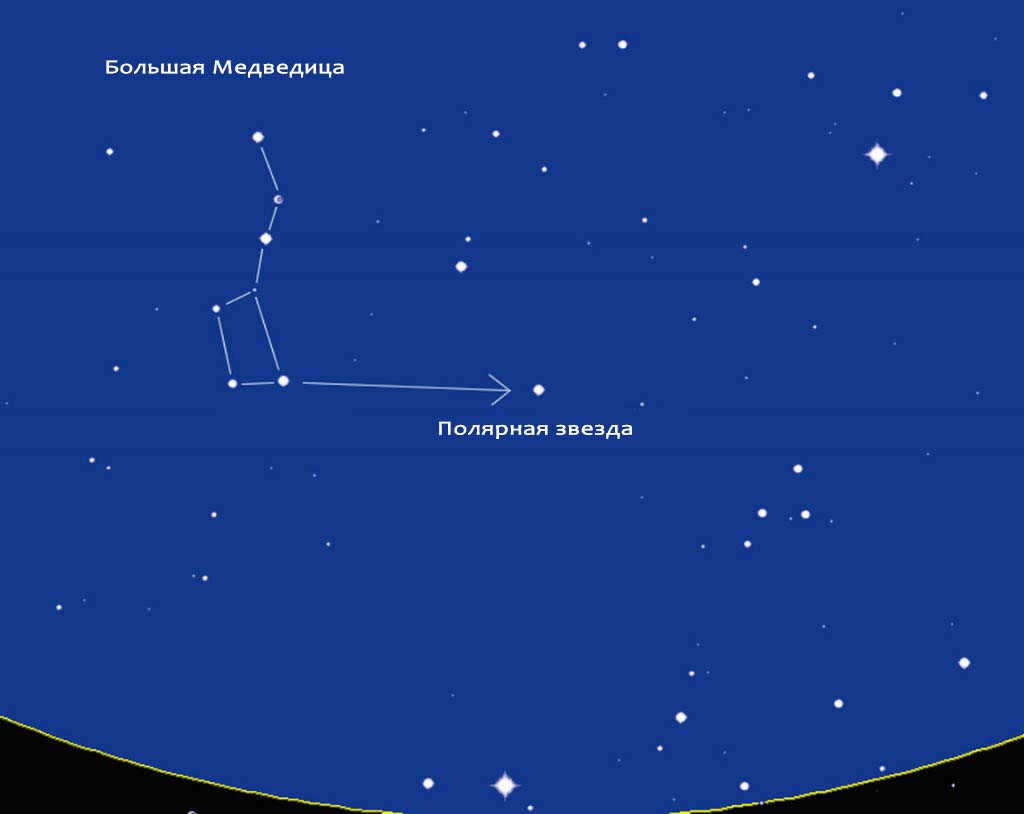
Discovering the location of Polaris
Even though the Alpha of the Little Bear can be observed slightly south of the equator (thanks to atmospheric refraction), it is not reliable for navigation in the southern hemisphere. If you desire to ascertain its position, a popular method involves envisioning a line connecting the two farthest stars of the Big Dipper.

The distance separating the stars that lead to Polaris is nearly five times the distance separating the stars of the “bucket”. Consequently, even though it remains stationary throughout the day, it is not at all challenging to locate.
Traveling to the North

Starry Night over the Rhone is an artwork by the famous artist Vincent van Gogh.
How to find your latitude
The determination of latitude is a fascinating process that involves observing the height of Polaris above the horizon. Situated near the Earth’s pole, Polaris remains almost stationary for any given location. However, its altitude above the horizon can vary depending on your position. For instance, if you find yourself at the North Pole, you will witness Polaris positioned almost directly overhead (at the zenith). On the other hand, if you are located at the equator (which is essentially on the “side” of our planet), Polaris will appear near the horizon. Consequently, by measuring the altitude of Polaris above the horizon, navigators of the past were able to determine their latitude while sailing northward. This method allowed them to figure out how far they had traveled north or south.
Origin of Polaris
The movement of the Earth’s North Pole has a rich history.
For centuries, Polaris has been a reliable guide for navigation, helping sailors and explorers determine their latitude and find their way north.
However, due to the phenomenon known as the precession of the equinoxes, as well as the natural movements of the stars, the role of Polaris has changed over time.
In the first millennium BC, the brightest star closest to the celestial pole in the constellation Ursa Minor was β, also known as the Little Bear. Although it was not close enough to become Polaris, it played a significant role in navigation.
Even earlier, in 320 BC, the Greek navigator Pytheas observed that the celestial pole was devoid of stars.
During the Roman era, the celestial pole was roughly equidistant from two stars in Ursa Minor: α, also known as Cynosura, and β, also known as Kochab.
In ancient times, historians chronicled the perpetual presence of Alpha of the Little Bear, noting that it remained in sight throughout the 5th century, positioned approximately 8 degrees away from the celestial pole.
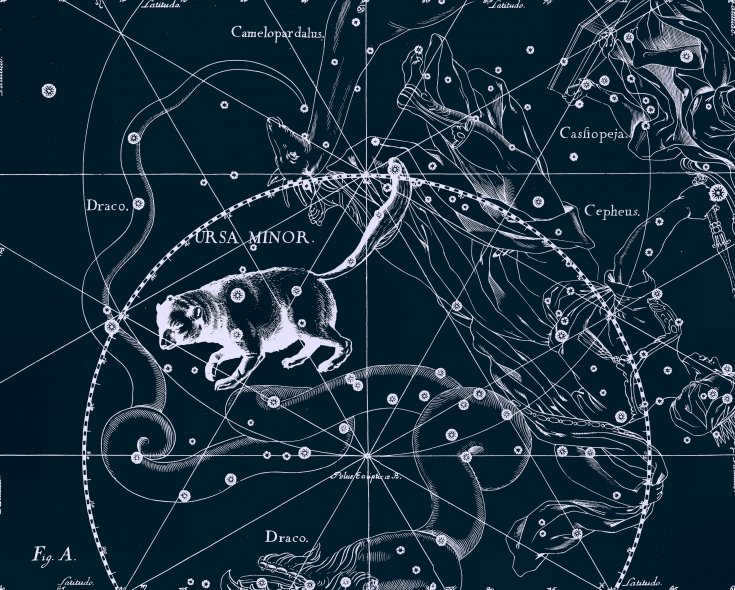

The constellation known as the Little Bear has been called Polaris since the 16th century, even though it was not exactly at the celestial pole during that time. In 1547, Renier Frisius calculated the distance between Polaris and the celestial pole to be 3 degrees and 7 angular minutes.

The precession of the equinoxes lasts for approximately 25,770 years. The maximum declination of the α star in the Little Bear constellation, considering both precession and proper motion, will occur at 89° 32'23" or 0.4603° away from the celestial north pole in February 2102. Its maximum declination, accounting for nutation and aberration, will be +89° 32'50 .62" or 0.4526° away from the celestial north pole on March 24, 2100.
Gamma Cephea, also known as Alrai and located 45 light years away from Earth, will be closest to the celestial north pole around 3000 AD.
Iota Cephei will assume the position of Polaris at a later time, around 5200 AD.
Alpha Swan Deneb will be within 5 degrees of the North Pole for the first time in 10,000 AD.
Alpha Lyra or Vega will become the new Polaris around 14,000 AD, being only 4 degrees away from the North Pole.
The position of the α star in the Little Bear constellation will change in the future, specifically in 27800 A.D. At that time, it will be further away from the pole than its current position. Conversely, in 23,600 B.C., it was closer to the pole than it is now.
The significance of α star in Little Bear mythology
In ancient Greek mythology, Polaris was known as Kynosoura, which translates to “Tail of the Dog” in English. Over time, this name transformed into Polaris and took on the meaning of “An object of attention and admiration.”
An interesting hypothesis suggests that the origin of the name Kynosoura was the constellation of the Little Bear in ancient times, as proposed by Allen and other researchers of star names.
Myths
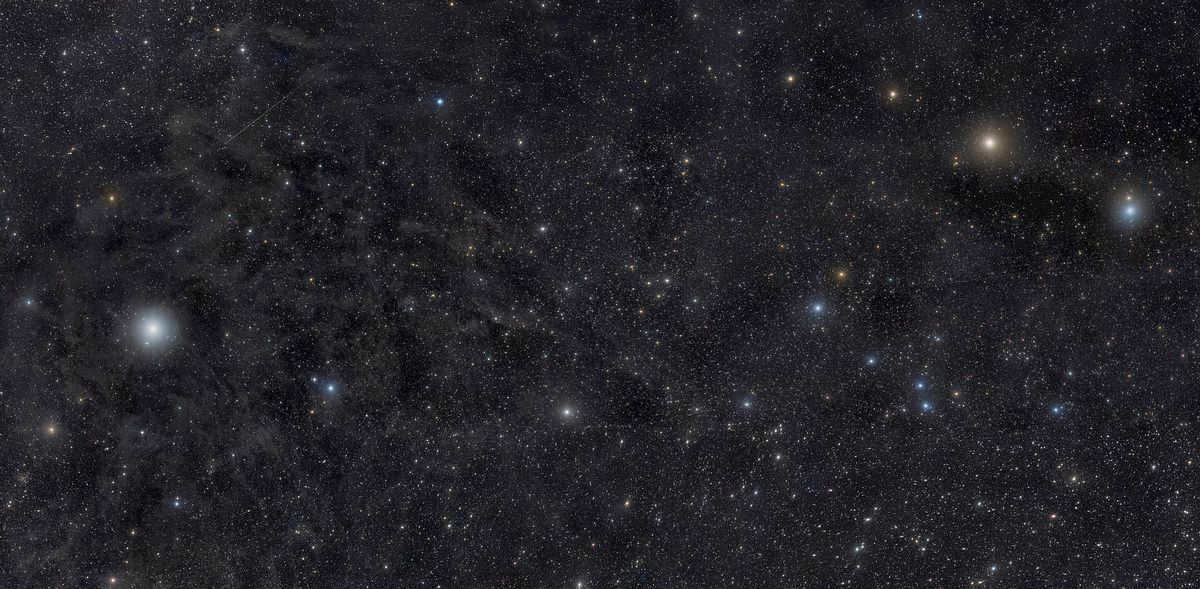
According to one version of the Zeus birth myth, the baby god was nourished in a cave for a period of time by two female bears named Kinosura and Helica. As a sign of gratitude, Zeus later raised them to the heavens. Kinosura transformed into the constellation known as the Little Bear, while Helica became the Big Bear. However, over time, the name Little Bear became associated solely with Polaris. This leads to the question: how did the bear acquire such a name?
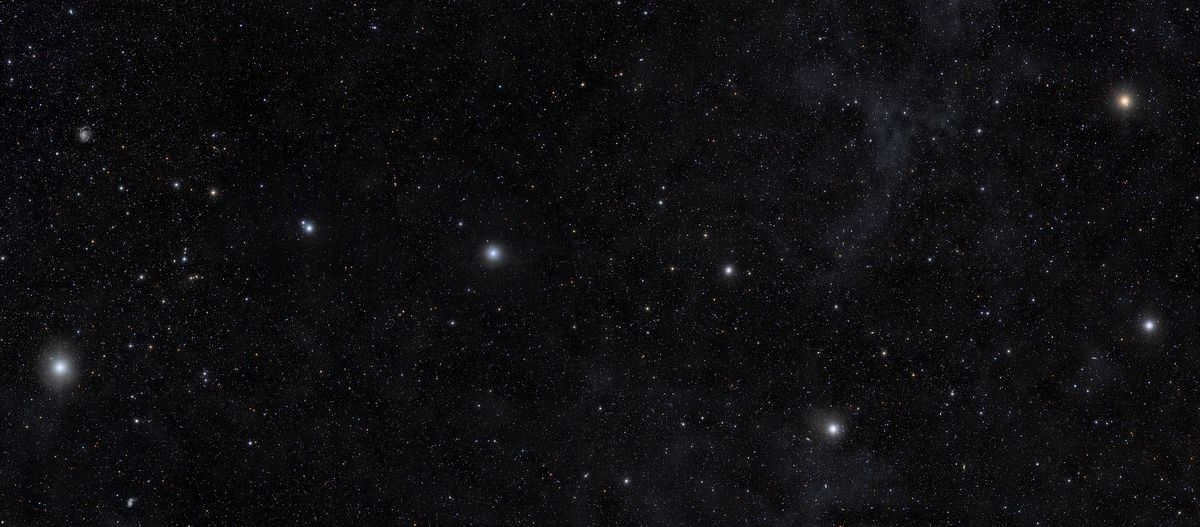
During ancient times, the Arabs held the belief that Polaris was simply a celestial void. They recounted a legend in which a malevolent star, known as Al Kiblah, managed to slay the Heavenly Warrior, who now rests eternally in a massive coffin that mirrors the arrangement of the Big and Little Bear constellations. In homage to the fallen hero, the remaining stars forever drift leisurely across the nighttime heavens.
Commonly Asked Questions
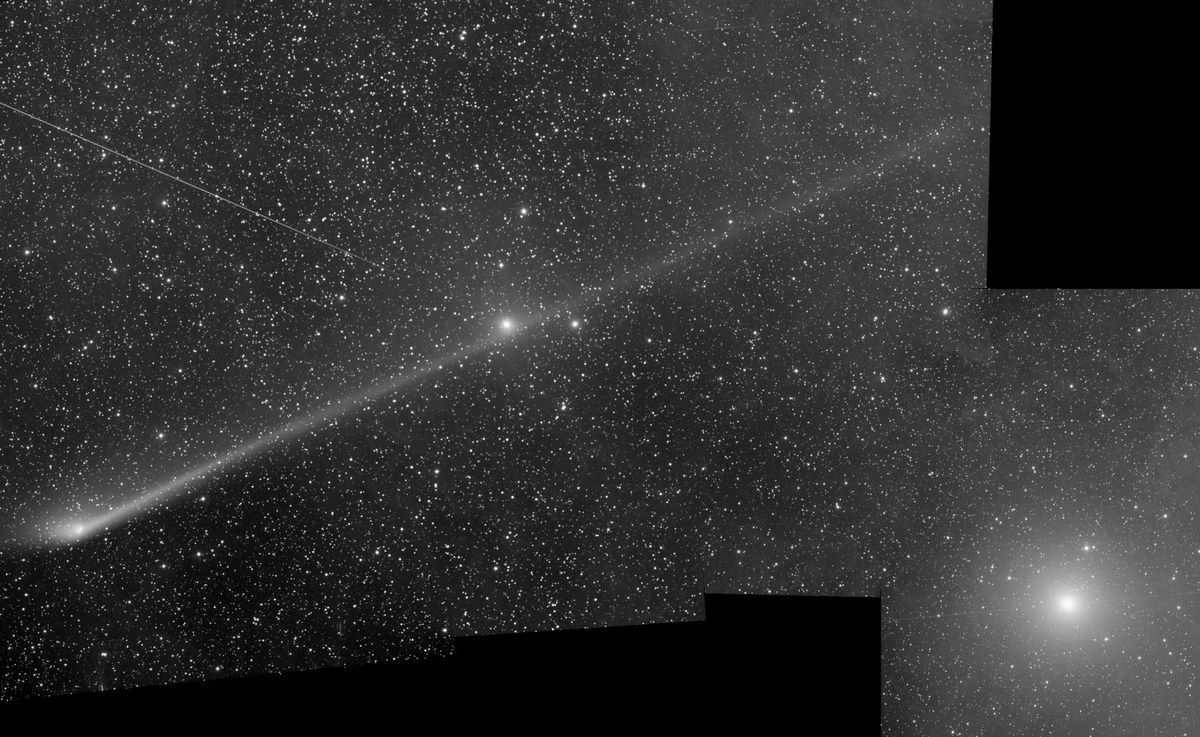
Comet C/2011 L4 Panstarrs and Polaris
Although there is a comprehensive description of Polaris in the constellation of Ursa Minor, some readers may still have queries about its location and how to navigate using it or which constellation it belongs to. We will attempt to address the most frequently asked questions.

Curiosity rover captures an image of the Martian night sky.
Those living in the Northern Hemisphere are fortunate – they possess the knowledge of how to locate Polaris, enabling them to determine the north even without the aid of a compass or landmarks. Polaris consistently remains in a fixed position in the sky and provides a more precise indication of north than any instrument. Astronomers frequently utilize this celestial object for accurate navigation on land. Furthermore, its elevation above the horizon corresponds to the geographical latitude. So, how does one go about locating this valuable celestial guide? Today, we will explore some fundamental techniques together.
What is the method for locating the Little Bear in relation to the Big Dipper?
It is a simple task for most people to locate the Big Dipper, as it stands out prominently in the night sky. Since the Big Dipper and the Little Bear are in close proximity to each other, it is relatively easy to find the Little Bear by using the Big Dipper as a guide. To accomplish this, mentally draw a line connecting the last two stars of the Big Dipper, which are Merak (β) and Dubhe (α). Extend this line upwards for a distance that is five times the distance between Merak and Dubhe. By doing so, you will discover Alpha (Polaris), which is the brightest star in the Little Bear constellation.
Before delving into the specifics of locating the Little Bear constellation, it is important to understand the pattern that the stars create and their relationship to the Big Dipper.
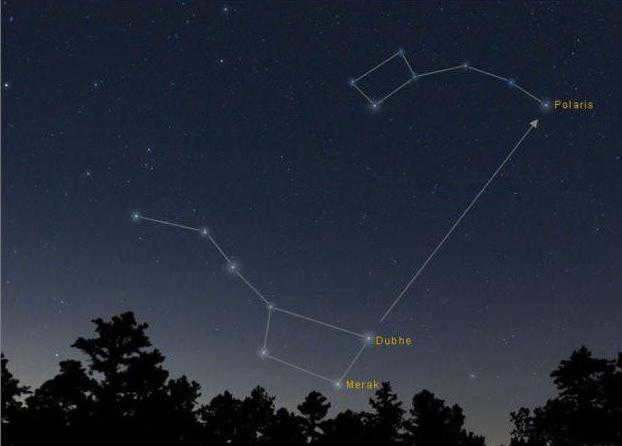
To gain a complete understanding: based on their given names, they bear a striking resemblance and mimic the configuration of a pail. When it comes to positioning, the Small Dipper is essentially inverted in relation to the Large Dipper.
To locate Polaris in the night sky, one can utilize the Big Dipper constellation. This can be done during the nighttime, when all the stars are clearly visible in the dark expanse above.
The steps for finding Polaris are as follows:
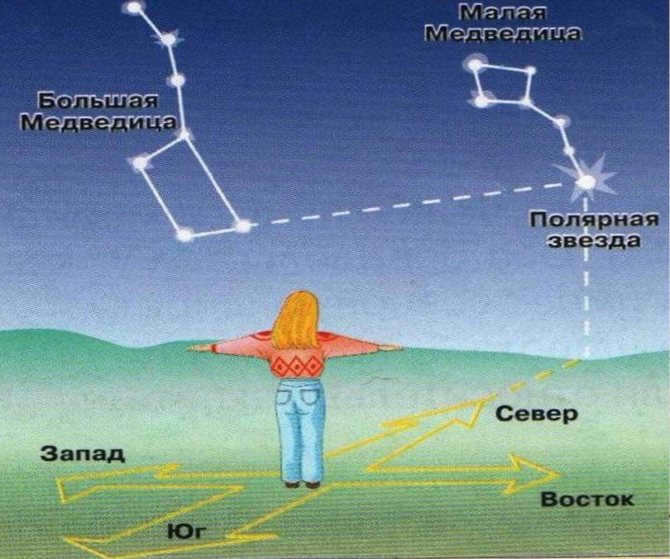
By using this method to locate the desired point, it is necessary to possess a sufficient degree of abstract thinking. It is crucial to accurately measure the size of the segments.
Acquiring knowledge gives you power
Prior to embarking on your search, familiarize yourself with the celestial map. This will greatly facilitate your quest for a particular constellation. Eventually, you will come to realize that locating the desired star cluster is a relatively simple task. Moreover, armed with comprehensive knowledge, you will be able to provide a clear explanation on how to locate the Little Dipper within the Big Dipper, should someone inquire about it.
Now that we have learned how to find the Ursa Minor constellation, let’s discuss Polaris. This star played a crucial role in enabling explorers and navigators of the past to undertake long and arduous journeys. Despite not being the most luminous star in the night sky, it is positioned closest to the northernmost point on Earth, with an error margin of only 1 degree. However, after a mere 145 years, the margin of error will exceed one degree.
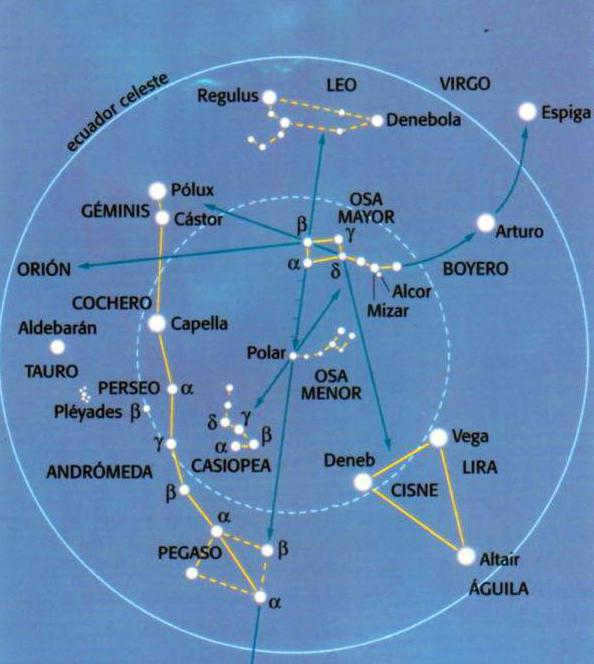
After the year 3200, the star closest to the northern point of the world will be Alderamin (alpha Cepheus).
"Twisting" the bear’s tail on the Earth’s axis.
Polaris remains in a fixed position, even as the Earth rotates on its axis and orbits the Sun. The brightness of Polaris varies, with a periodicity of 4 days, within a range of 2.02 ± 2%. In the past, the amplitude of luminosity was higher, but it has now stabilized. The total brightness of Polaris is constantly increasing and has risen by almost 15% over the past hundred years.
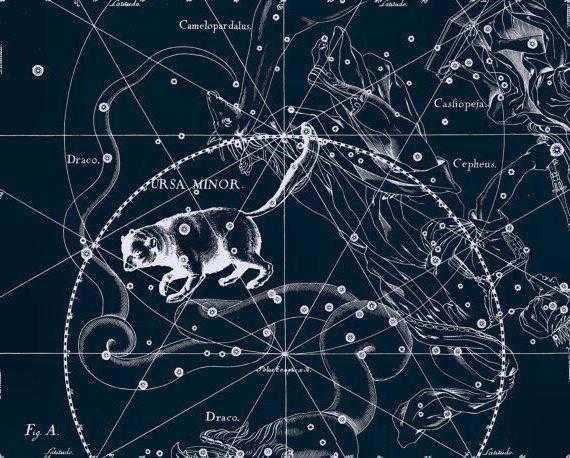
As mentioned earlier, the asterisk is the location of the North Pole of the World, which is the point on the celestial sphere around which all objects revolve. The first mention of this point in historical sources was by the Greek astrologer Ptolemy in the 2nd century.
Characteristics of the celestial body
The discovery of Polaris occurred many millennia ago, but it was not yet considered the pole of the world at that time. The Earth’s cosmic axis is constantly moving at a high speed on the universal scale, so another planet previously occupied the position of the current polar point.
Polaris, also known as Polaris and Kinosura, will only remain in that position for a short period of time. After tens of millennia, the planet Vega will indicate the northern direction.
Polaris, also known as the North Star, is a prominent star located in the handle of the Big Dipper constellation. It is situated at a distance of hundreds of light years from Earth and is much larger in mass than our own Sun. Despite its size, Polaris is not the brightest star in the sky, so it may not be immediately noticeable.
One unique characteristic of Polaris is its position almost directly above the North Pole. This means that as the Earth rotates, Polaris remains stationary in the night sky while other stars and constellations appear to move. This makes Polaris a reliable point of reference for finding the north direction.
Using Polaris to determine the north direction is more accurate than relying on a compass, which can be affected by magnetic declination. Polaris is located precisely on the Earth’s axis, making it a reliable guide.
The Tiny Bear and its celestial bodies
The group of stars known as the Tiny Dipper consists of seven luminous objects. Out of all the bright stars in the Tiny Dipper, only the three most radiant ones are easily seen. These stars, named Ferhad and Cohab, create the boundary of the Bucket shape, while Polaris sits atop the handle of the constellation. The last two stars can be found above the tail of the Big Dipper.
The Lesser Bucket stands apart from other constellations in a few ways. Unlike the Big Dipper and most other stars, which shift positions in the sky depending on the season, the Lesser Bucket remains stationary. These asterisks can only be observed during certain seasons and move across the sky throughout the year. The Tiny Bear also changes its position as it orbits around its Alpha star.
What is the Purpose of Polaris? Tips and Tricks for Locating the North Star
By Sergey Fedoseev
When it comes to navigation, one cannot overlook the importance of using stars as guides. This is a vast subject with numerous aspects to explore. To fully grasp the knowledge of identifying different constellations and utilizing them to find the north, one must delve into extensive reading and memorization. Clearly, this cannot be condensed into a single article. In this brief piece, I will solely focus on providing instructions on how to locate Polaris in the night sky in order to determine the direction towards the north.
First and foremost, what exactly is Polaris and why is it important?
It is common knowledge that the Earth revolves around its axis, causing the appearance of a rotating night sky and shifting stars. However, astute observers will notice that all constellations pivot around a single point known as the celestial pole. This pivotal point is where Polaris resides. Polaris remains nearly stationary in its position and its direction always aligns with the north, while other stars continually change their positions in the sky.
What is the method for determining north using Polaris?
The process of finding the north direction by Polaris is quite simple. All you have to do is mentally visualize a vertical line extending from this star to the visible horizon. The point where this line intersects the horizon will indicate the north direction. Consequently, the opposite direction will be south, the right side will signify east, and the left side will indicate west.
The Alpha (Polaris) of the Little Bear is situated about 431 light-years away from our planet Earth. With a visible brightness rating of 2.02, it has recently been discovered that this celestial body is not just one star, but rather a system comprising three stars. The most luminous star in this system shines with a brightness nearly 2,000 times greater than our Sun. The second star in the Little Bear system has a mass equivalent to 1.39 times that of the Sun.

The polar bear constellation can be easily observed using a small telescope. The third star, known as Alpha, is 1.25 times more massive than our Sun and is located in close proximity to the first star. Thanks to the advanced capabilities of the Hubble telescope, it is now possible to view Alpha as a separate and distinct star.
Kohab, also known as the Star of the North, is an orange-colored giant. It is the second brightest star, referred to as beta, in the constellation of the Lesser Dipper. Kohab has a stellar magnitude of 2.8 and is located approximately 126 light-years away from Earth.
Ferhad is the gamma star of the Little Dipper. It has a magnitude of 3.6 and is situated at a distance of 480 light years from Earth. Ferhad is classified as a hot giant with a temperature of 8600 K and is categorized as a variable type of star.
The Little Bucket’s Delta, also known as Yildun, is a white dwarf situated 183 light years away.
Zeta, another white dwarf, is located 380 light years away from our planet. It has a luminosity that is 200 times greater than that of the Sun. It is currently in the process of transforming into a giant star.
How can I locate Polaris?
Now that we have identified what Polaris is, it is time to begin the search. There are two main methods to consider: searching by constellations and using technical means.
Searching by constellations
If the sky is clear and your eyesight allows you to see at least the brightest stars, the most straightforward and efficient approach to finding Polaris is by using constellations. This method offers the advantage of accuracy, as the stars remain fixed relative to each other. Additionally, Polaris is part of the constellations, specifically located at the end of the “tail” of the Little Bear constellation and serving as its brightest star.
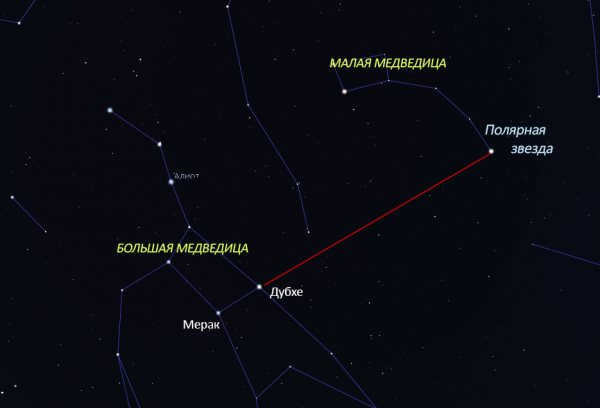
The Big Dipper, Little Dipper and Polaris
To locate the constellation of the Big Dipper in the sky, specifically its main part, the Big Bucket, there are a few simple steps to follow. The wide part of the bucket, opposite the “tail,” is formed by two stars – Merak below and the brighter Dubhe above.
Now, let’s visualize the Big Dipper and its Bucket. On the left, we have the tail and narrow side of the bucket, and on the right, we have the wide side. On the wide part, we can find two stars and draw a straight line from the less bright Merak to the brighter Dubhe. If we measure a distance equal to 5 times the distance from Merak to Dubhe, we will arrive at the tip of the tail of the Little Bear and Polaris. Polaris is the brightest star in that area, making it easy to identify.
It’s important to keep in mind that this technique primarily concentrates on the individual constellations. The Great Bear and Small Bear, along with other constellations, are continuously moving through the sky – the Bucket can be both upside down and upright. To help facilitate drawing a straight line across the sky, utilize a ruler, a stick, or your finger to ensure you locate Polaris.
The Small Bear, Cepheus, and Cassiopeia
The Big Dipper is quite a large constellation and can sometimes be obstructed by clouds or tall buildings and trees. However, the smaller yet equally distinct constellation Cassiopeia can also assist in locating Polaris. Depending on its position, Cassiopeia resembles either the letter “M” or “W” with slightly elongated edges. Its central arrow always points towards the constellation of the Little Bear, where Polaris is situated. To verify this, you can look for the Big Dipper nearby or Cepheus, a constellation between the Little Dipper and Cassiopeia, which resembles a house with a roof.
Let’s explore all of these methods together. The illustrations above depict the stars of the spring sky over Moscow. The image below shows the Sochi sky on the same day, without any labels or names. Can you locate Polaris in it?
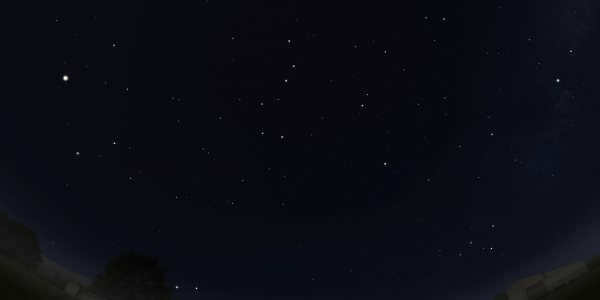
Out of all the stars, one stands out – Polaris. Do you know where it is? Well, you’re in luck because it’s right here.

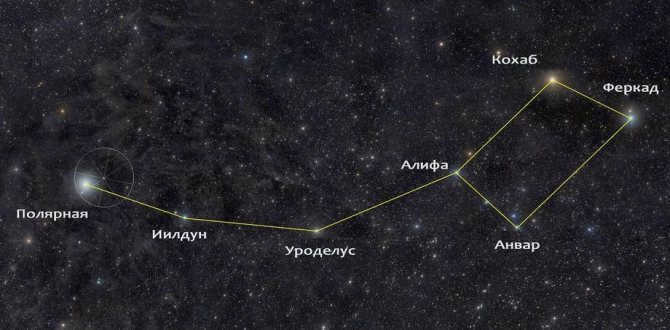
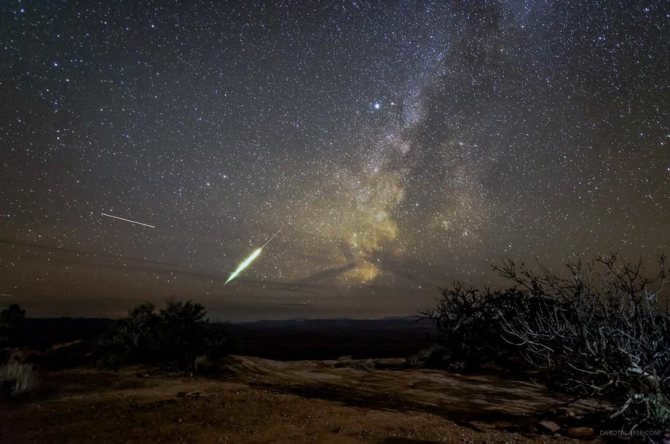
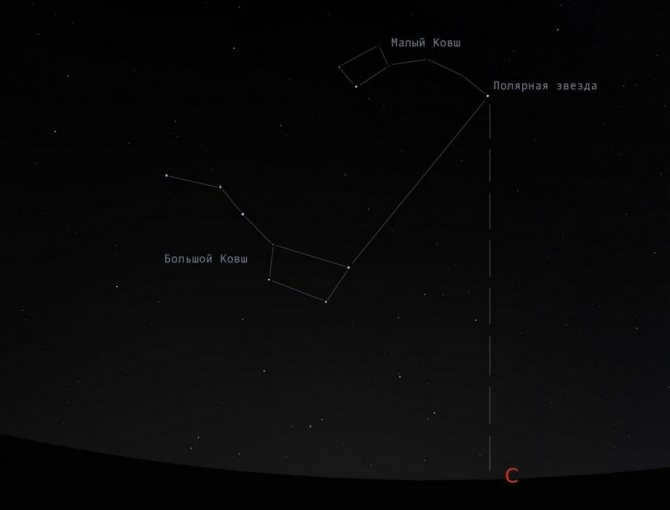
The night sky holds countless enigmas and riddles.
Simply gazing upwards, even without the aid of a telescope, will unveil the vastness and diversity of our magnificent universe.
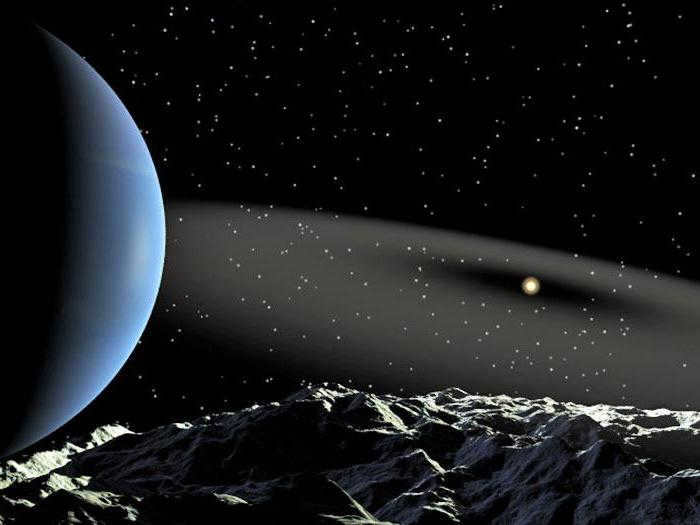
The Little Dipper constellation represents only a small visible portion of the vast expanse that is our Universe. The boundaries and size of what we can currently perceive are well-defined, measuring a staggering 14 billion light years in length.
However, is this the true nature of the Universe? This question ignites the curiosity of brilliant minds, prompting them to hypothesize, investigate, debate, and strive to comprehend its reality. Some experts posit that the Universe is infinite, while others propose the existence of a Multiverse.
It is entirely plausible that within one of these alternative universes, an identical planet, country, and even a replica of yourself exist. The realm of possibilities knows no bounds, as science consistently unravels the mysteries that lie beyond our perception, proving time and again that what may appear fantastical today may become our reality tomorrow.

Polaris, without a doubt, is one of the most renowned and well-liked celestial objects. It is safe to say that there is hardly anyone who is unfamiliar with it.
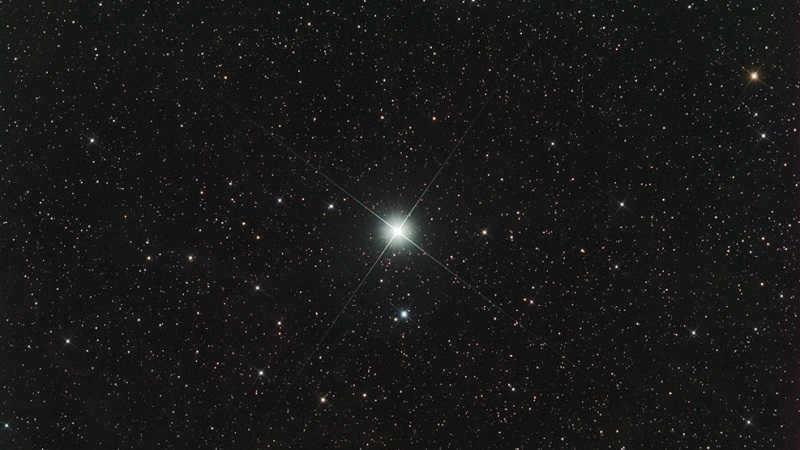
The object Alpha of the constellation of the Little Bear now occupies the position formerly held by Polaris.
According to scientists, Polaris is classified as a delta Cepheus variable, specifically a Cepheid.
Interestingly, Polaris is known for its pulsations, which have been decreasing over the course of several decades. For instance, its brightness has decreased from 8% to 2% between 1900 and 2005. However, overall, it has become significantly brighter during that time.
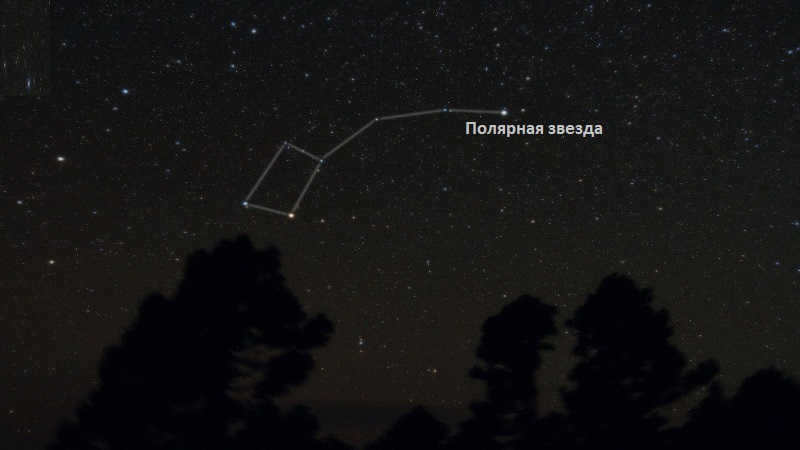
It is worth mentioning that this particular star is the most brilliant and closest among the other stars in its category that are located near our planet. It possesses a visual magnitude of +2.0m. Furthermore, its current distance from Earth is estimated to be approximately 447 light years or 137 parsecs.
As previously mentioned, the Alpha star of the Little Bear constellation is the nearest Cepheid star, which holds significant value in the field of astronomical distance measurement.
Cepheids are a group of pulsating variable stars that exhibit a correlation between their period of pulsation and their luminosity.
What is the name of Polaris?
Polaris is known by various names throughout history and different cultures. In ancient Greece, it was called Kinosura, which means “the tail of a dog” in translation. In England, it is referred to as the pole luminary, a celestial object that is worthy of attention and admiration. It is also commonly known as the Guiding Star or the North Star due to its position and navigational significance.
Polaris serves as a beacon in our sky.

Description of Polaris
First and foremost, Polaris, also known as the Alpha of the Little Bear, is not just an ordinary star, but rather a complete stellar system comprised of three elements.
Located at the very center is a supergiant star called Polaris A (α UMi A), which has a companion known as Polaris P (α UMi P). This duo forms a close binary star system. It is worth mentioning that the main component, being a supergiant, is one of the brightest celestial bodies.
Lastly, there is a third component known as Polaris B, which is situated at a considerable distance from the central object.
When discussing the characteristics of Polaris, it is important to acknowledge its physical attributes. Surprisingly, Polaris shines brighter than our Sun and possesses a larger size.
What shade do you believe Polaris is? A lot of individuals incorrectly assume it to be white. Nevertheless, when you observe it from Earth with the aid of a telescope, you can observe that Polaris’ hue is in fact more akin to yellow.
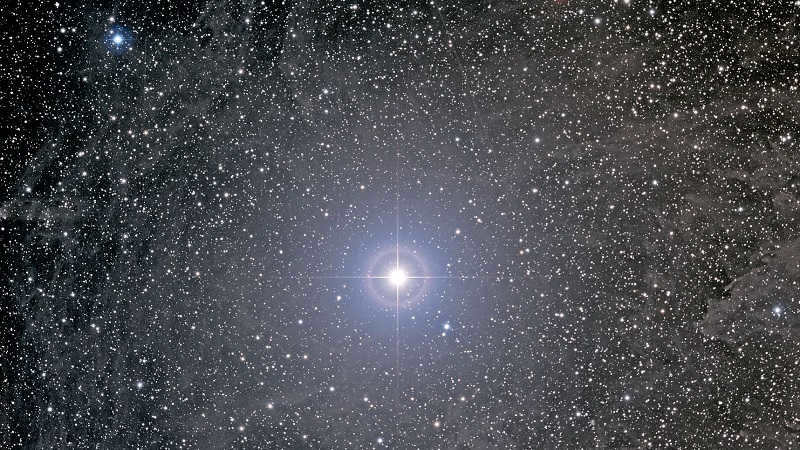
Additional characteristics of Polaris
Due to the phenomenon of luni-solar precession, which involves the change in the direction of a celestial body’s axis of rotation in space, the Earth’s axis moves in a circular motion, resulting in different stars being closest to the North Pole over time. Since Polaris is a specific name, it can be replaced by various objects at different periods.
For instance, in the past, the following stars were positioned above the northern point of the horizon: Vega – α Lyra; π, η, and τ of Hercules; ι and α Dragon; β of the Little Bear.
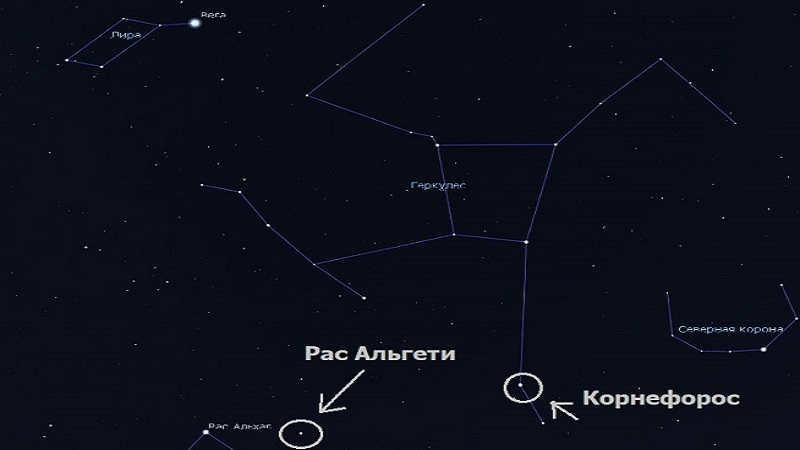
Now begins the era, if you will. Alpha of the Ursa Minor. Astronomers predict that it will continue until the year 3200. After that, the northern position will be taken over by Gamma Cassiopeiae, Beta Cassiopeiae, and Alpha Cephei, as well as Alpha Cygni and Gamma Cygni.
In the end, the throne will once again be held by Alpha Lyrae — Vega.
By the way, this is known as the precessional cycle, in which the positions of the stars relative to the celestial equator change.
What do you think is the altitude of Polaris? Its altitude above the horizon corresponds to the geographical latitude of the observer’s location. In fact, its direction is nearly identical to the direction of north.
The Northern Hemisphere uses the North Star for orienteering and determining geographic latitude as it is situated above the northern point of the horizon.
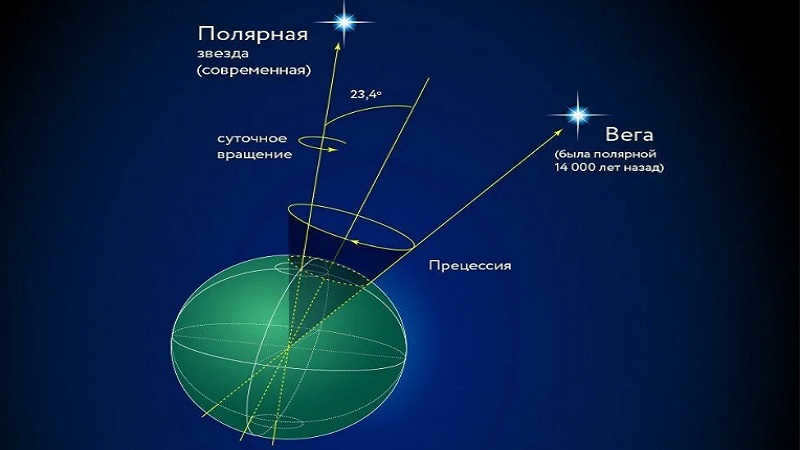
Many individuals are curious about what shines brighter than Sirius or Polaris. Let me make it clear: Sirius is the brightest star in the sky, while Polaris is the brightest among the stars in the Northern Hemisphere.
Now the question arises: how much brighter is Sirius compared to Polaris? The answer is 27 times brighter! However, it’s important to note that Polaris is 53 times farther away. Therefore, its actual luminosity level is 300 times greater than that of Sirius.
Where can Polaris be found in the sky?
Polaris is situated close to the North Pole of the Earth. More precisely, it is positioned within the constellation Ursa Minor, also known as the Little Bear.
Scientists have determined that Polaris is currently less than 1 degree away from the North Pole. As a result, it remains nearly stationary in the daily rotation of the celestial sphere. Consequently, Polaris can be seen directly overhead from the North Pole, at the zenith.
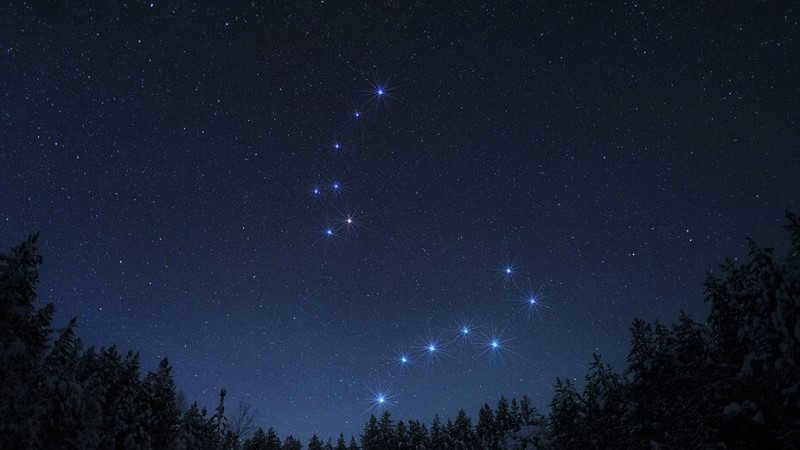
What is the Southern Polaris
Clearly, in the southern hemisphere, the Northern star is not visible. Consequently, it is simply impossible to orient oneself using it. There is no trace of a shadow from Polaris.
Essentially, it is a star that is situated at the South Pole, specifically on its axis. However, there is currently no such celestial body. The nearest one is Sigma Octanta. However, it cannot be used as a navigational aid. In some cases, people refer to the Southern Cross constellation, as it at least points towards the South Pole. It can be considered as a sort of landmark.
When embarking on a journey, we always bring along a smartphone with a built-in navigator to help us navigate our way. However, what happens when the device runs out of battery and we find ourselves lost? It is in these moments that we are reminded of the ancient methods our ancestors used to navigate using the stars, the Sun, and the Moon. So, how can we locate the North Star – the timeless guide of humanity?
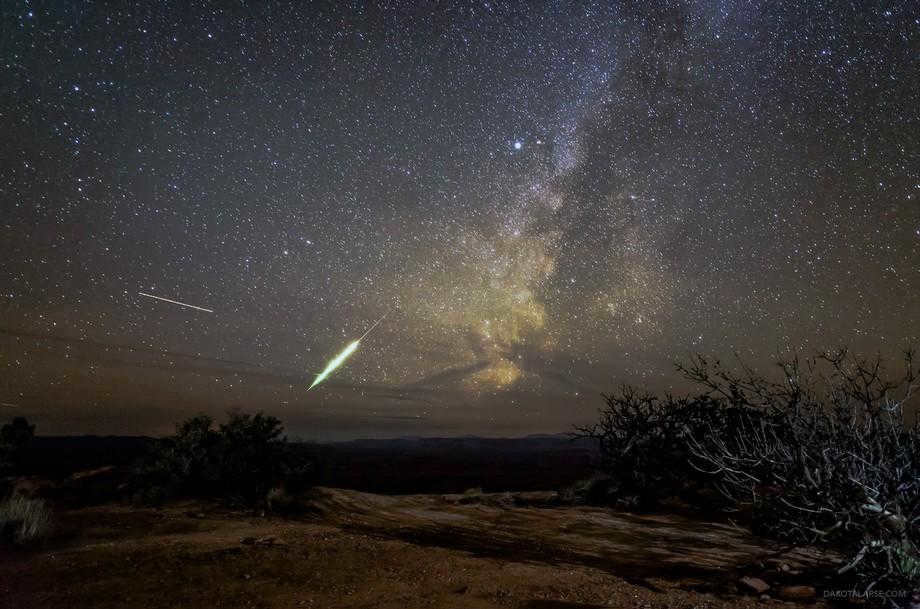

Finding Polaris in the Sky
During the late evening or at night, Polaris is easily visible in the sky. The only requirement is that the night must be clear and free of clouds.
The Earth and other celestial objects are constantly in motion. Many people wonder how to locate Polaris and “capture” it when everything in the world is continuously shifting. Travelers in the Northern Hemisphere can rest assured. Polaris, also known as the North Star, remains in a fixed position relative to humans at all times. It serves as an accurate guide for orientation in space.
Seasoned adventurers who have relied on Polaris for guidance know that it consistently remains in the northern direction. Its deviation from its path is minimal, with only a slight error of 1.5 degrees. While this measurement is significant for navigation purposes, it is irrelevant for a disoriented traveler, making it a foolproof means of finding one’s way in space.
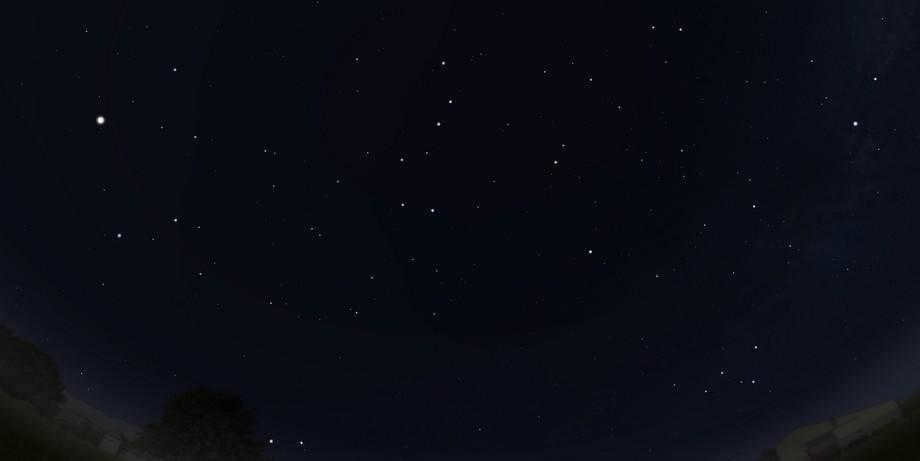
In order to determine the location of the bright guiding light, it is necessary to gain some knowledge about observing the night sky. Locating Polaris becomes an easy task if one understands the positioning of the constellation known as the Big Dipper (or “big dipper” as it is commonly referred to).
The Big Dipper consists of 7 stars arranged in a shape that resembles a large ladle with a handle. The “ladle” can be seen in all regions of Russia, except for the southern regions during the fall season. During that time, the Big Dipper is hidden below the horizon.
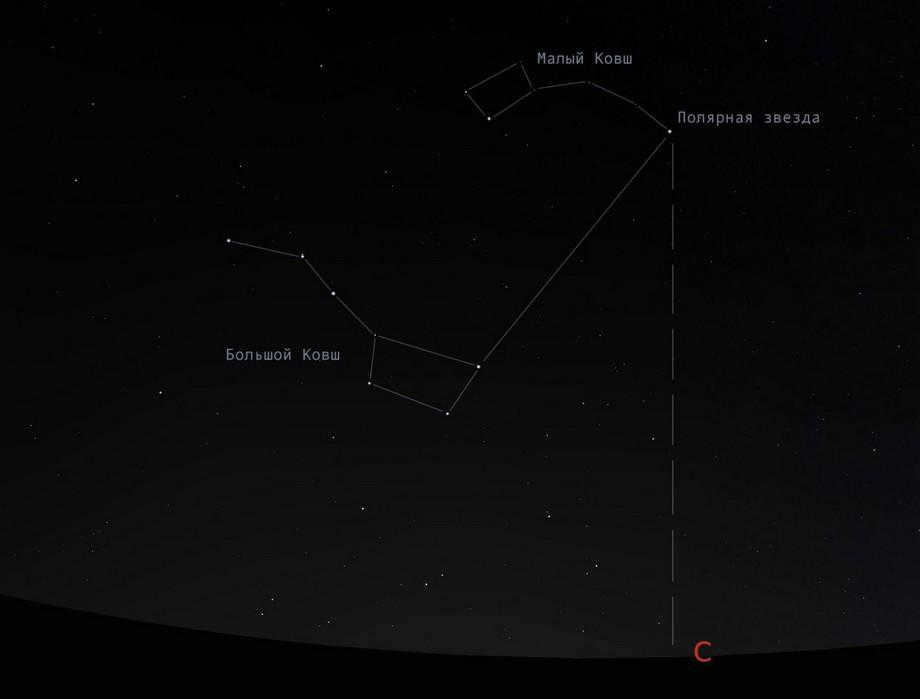
So, after locating the Big Dipper constellation in the night sky, we can easily determine the position of Polaris, also known as the North Star, using it as a guide:
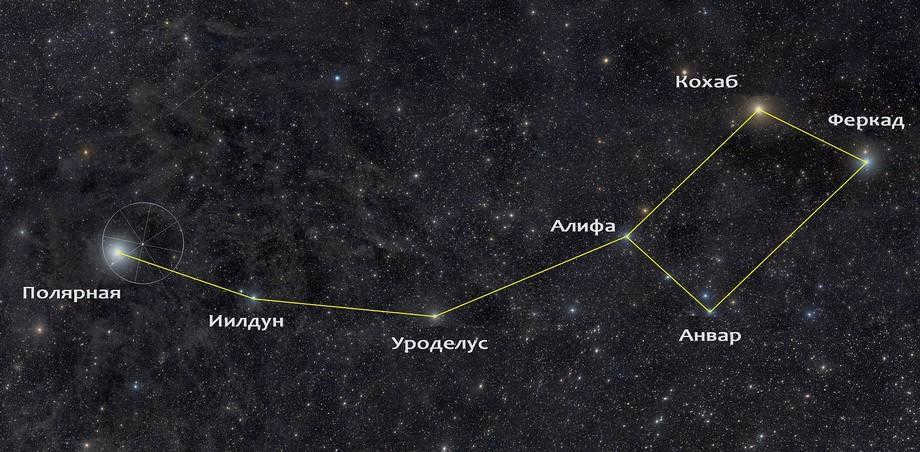
The northern direction has been located. The next step is to establish the cardinal directions. To do this, face north and extend your arms in different directions. The left side will be the West, the right side will be the East, and the South will be directly behind you. This technique is applicable in the northern hemisphere.
The Southern Cross: a notable feature in the southern hemisphere
Residents of the southern hemisphere have a distinct point of reference known as the Southern Cross, which cannot be seen in our latitudes. This constellation consists of four stars arranged in the shape of a cross. In close proximity to it, there is another constellation called the False Cross. The main difference between the two is that the stars in the False Cross are positioned further apart from each other compared to the Southern Cross.
To determine your direction in the southern hemisphere, focus on the southern sky. Mentally draw a line along the stars that form the vertical “crossbar” of the Southern Cross. To ensure accuracy, it is recommended to wait until the constellation is fully upright in the sky. Once it is positioned perpendicular to the horizon, you will find that the south is directly beneath the Southern Cross.
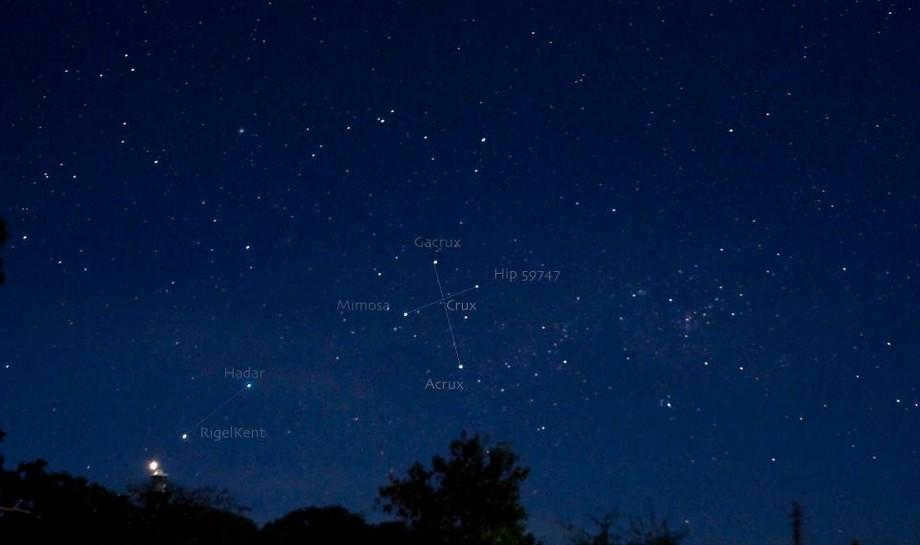
Locating your Direction using the Sun
If the sky is clear, you can determine your direction at night by observing the stars. During the day and in the morning, you can rely on the Sun to guide you. How can you navigate using the Sun? It only requires basic geographical and topographical knowledge.
The Sun always rises in the east and sets in the west. At noon, the shadow of the Sun points towards the west.
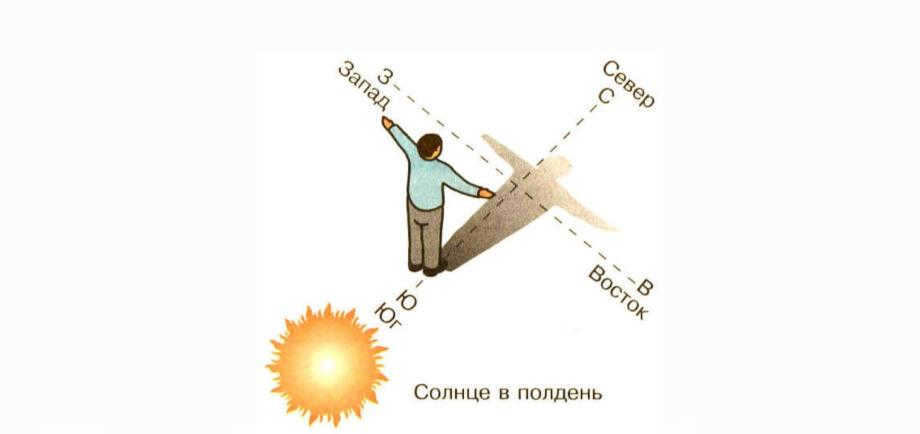
Finding your way is not just convenient. In case you don’t have a watch or if they are misplaced, you can always use the Sun to determine the time of day. All you need to do is set up a pole or a stick vertically in the ground. Then, draw a clock face around it. Now, observe the shadow’s movement on the drawn dial. This will give you an approximate time. What’s interesting is that the maximum error in this method is only around 10%.
Guide to Moon Navigation
Aside from using Polaris as a navigational reference point, another celestial body that can aid in navigation is the Earth’s satellite – the moon. On a clear night, the moon emits a particularly strong glow. When the crescent shape of the moon is increasing, it can be found in the western sky, while during its waning phase, it can be seen in the eastern sky. In the evening, when the moon is in its first quarter, it can be observed in the southern direction. As it reaches its full phase, it can also be found in the south, specifically during the first hour of the new day.

By 7 a.m., you can also spot the first quarter Moon on the southern side of the sky.
The changing positions of constellations throughout the year
How can you use other constellations to navigate? They can also help you determine the right direction. Astronomers observe the shifting positions of constellations, not just at night, but throughout the year.
At midnight, if you look towards the south, you will see the following constellations:
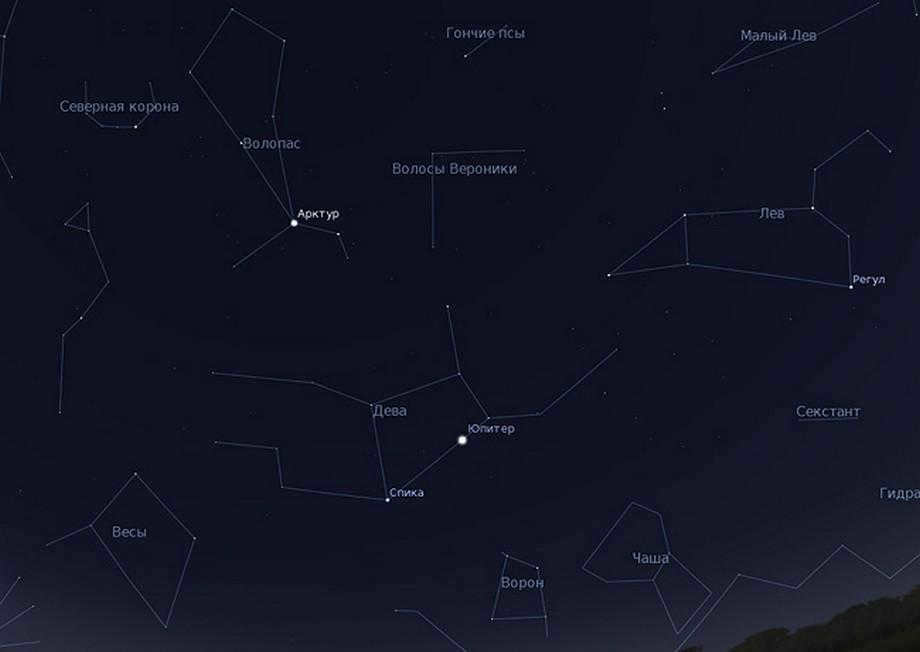
Our galaxy, the Milky Way, can be seen in the sky when looking north from the south, and it can sometimes act as a reliable safety net.
Constructing a mini-observatory
To learn how to navigate using the stars, you can set up a small observatory anywhere. You will need two poles: one above and one below. Then, observe the movement of the larger stars on the celestial sphere in relation to the poles embedded in the ground. Keep in mind that you can observe all stars except Polaris, which, as mentioned before, remains stationary relative to a person.
When any other star moves upwards, it indicates that we are facing east. If the star moves downwards, we are looking at the western part of the sky. When the star begins to “loop” to the right, it is pointing north, and if it starts looping to the left, it is pointing south.

